Overview of Istanbul
Blue Mosque
Hagia Sophia
Cistern
Topkapi Palace
Grand Bazaar
Egyptian Bazaar
Istanbul
Wow – We made it to
Istanbul! As soon as we near the
city, we see ruins. Our guide,
Hakan, tells us that these are the original walls of Constantinople. On
one side, the ruins of the gates and walls, on the other, the Sea of Marmara,
which is lined with ships, and beyond that, Asia!
The
reason the cargo ships are all at anchor (and there are probably well over a 100 of them)
is that to get to the Black Sea, they have to go through the very narrow
Bosporus. So they wait, in order of
arrival, to get permission to enter the Bosporus.
Although I don’t know this to be a fact, I saw no large cargo ships in
the Bosporus while we were in Istanbul, although it was full of both private
boats and fleets of ferries and tourist ships.
I suspect the cargo ships sail through only at night.
We walked and walked in
Istanbul, and it was terrific. You
will see pictures of the wide park-like area we walked as we went from one site
to another. The flowers were
beautiful and the park was carefully maintained.
I could sit on a bench and watch the fountains forever.
So let’s start our tour
of Istanbul, knowing that this is the location of both the first days and last
days on our Turkey tour.
Tour will include:
|
Overview of Istanbul | |
|
Blue Mosque | |
|
Hagia Sophia | |
|
Cistern | |
|
Topkapi Palace | |
|
Grand Bazaar | |
|
Egyptian Bazaar |
ISTANBUL
Istanbul
(Turkish: İstanbul, historically also known
as Byzantium and Constantinople) is the largest city in Turkey and fourth
largest city in the world with a population of 12.8 million, also making it the
second largest metropolitan area in Europe by population, and the largest
metropolitan city proper. Istanbul is also the cultural, economic, and financial
centre of Turkey. The city covers 39 districts of the Istanbul. It is located on
the Bosphorus Strait and encompasses the natural harbor known as the Golden
Horn, in the northwest of the country. It extends both on the European (Thrace)
and on the Asian (Anatola) sides of the Bosphorus, and is thereby the only
metropolis in the world that is situated on two continents.
In
its long history, Istanbul has served as the capital city of the Roman Empire
(330–395), the Eastern Roman Byzantine) Empire (395–1204 and 1261–1453),
the Latin Empire (1204–1261), and the Ottoman Empire (1453–1922). The city
was chosen as joint European Capital of Culture in 2010. Historic areas of
Istanbul were added to the World Heritage List in 1985.
Names
of Istanbul
Byzantium (Greek: Βυζάντιον, Byzántion) is the first known name of the city. Around 660 BC, Greek settlers from the city-state of Megara founded a Doric colony on the present-day Istanbul, and named the new colony after their king, Byzas. After Constantine I (Constantine the Great) made the city the new eastern capital of the Roman Empire in 330 AD, the city became widely known as Constantinopolis or Constantinople, which, as the Latinised form of "Κωνσταντινούπολις" (Kōnstantinoúpolis), means the "City of Constantine". He also attempted to promote the name Nea Roma ("New Rome"), but this never caught on. Constantinople remained the official name of the city throughout the Byzantine period, and the most common name used for it in the West until the establishment of the Republic of Turkey.
Entering Istanbul
As we bus in, we see portions of the old walls of Constantinople.. In some places the wall as gone, in others, it appears that it has been incorporated into a building, even a home.
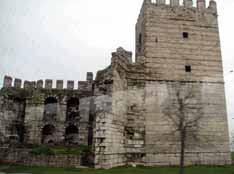


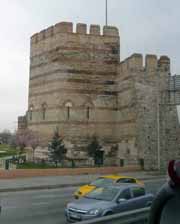


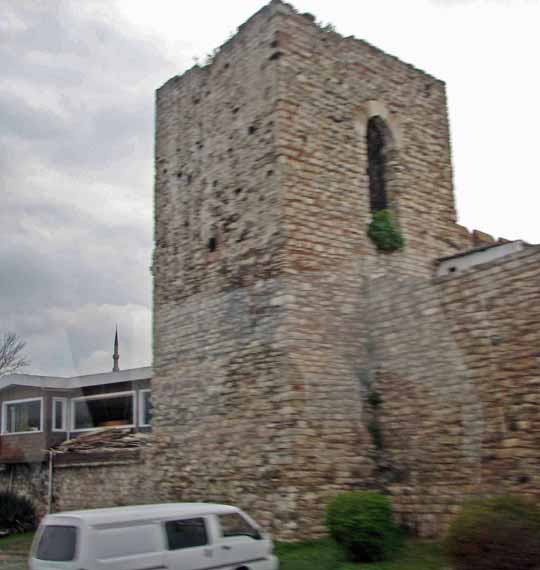
Remember this set of ruined pillars - you'll need to see what eventually happened to them.
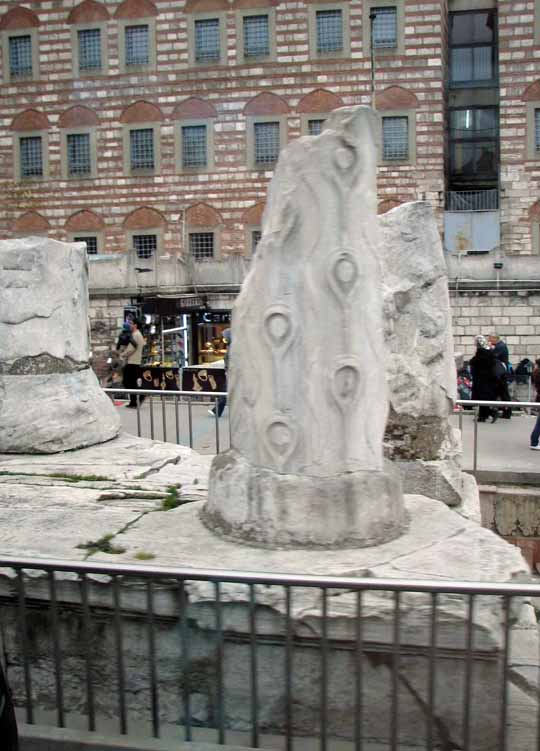
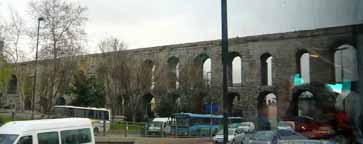
We also see a section of the Constantine Aqueduct. Although there's not much left, what remains certainly attracts your attention. It is remarkably handsome, and as you'll see, modern traffic goes through it.


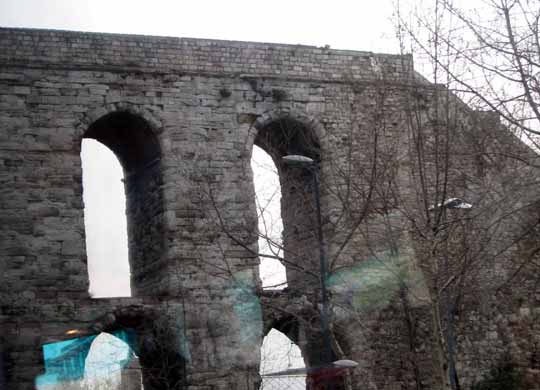
As we enter Istanbul, we see ships by the score lined up to travel the Bosphorus Strait to the Black Sea, and see Asia in the distance.
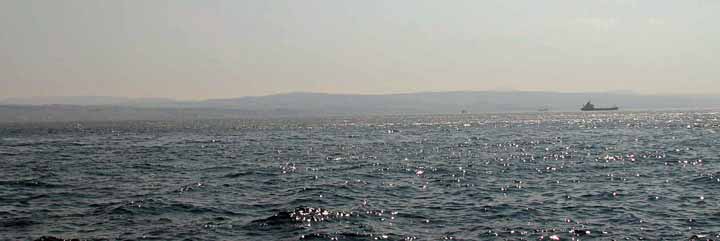

They wait to sail the Bosphorus. This bridge below leads from a harbor to the Bosphorus.
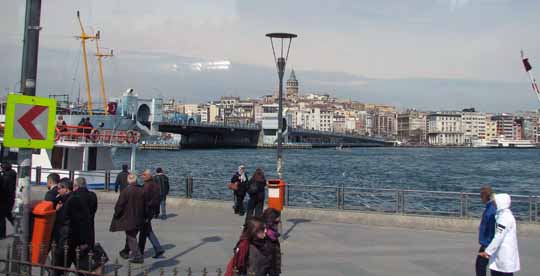
The streets of Istanbul remind us of Greece - narrow and hilly.
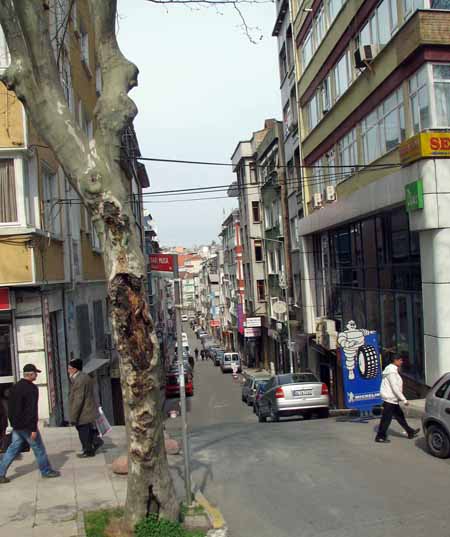
Markets grace some streets - these are near the waterfront


Traffic seems the same the world over, but we'll admit, other than an absolute disregard for pedestrians, this is some of the better mannered drivers we've seen in our travels - just avoid very narrow streets with cars parked on both sides.


A bus-eye view of part of Istanbul.

View across the Bosphorus

Tulips!
We travel streets lined with tulips. Hakan tells us that Turkey is the actual home of tulips, not the Netherlands! Tulips were developed here in Turkey. A number of bulbs were sold to the Dutch, and as Turkey entered their years of wars, Holland took over the trade. In homage to the birthplace of the Tulip, Holland sent (and I can't recall the actual number) perhaps one and one-half million bulbs to Turkey to plant on their streets. They had just started to bloom as were visited.

We get out of the bus to walk to the blue Mosque. We walk through a beautiful park, lined with flower beds, small statues and fountains. The park was once the fabled Constantine Hippodrome.

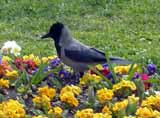
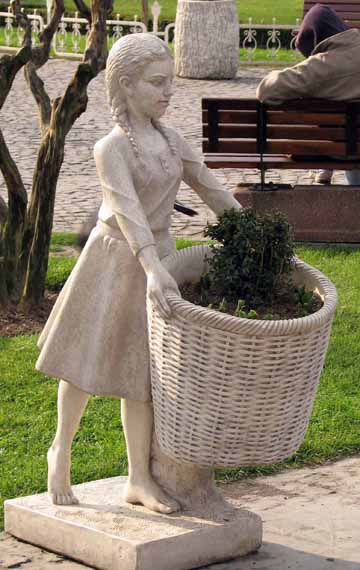
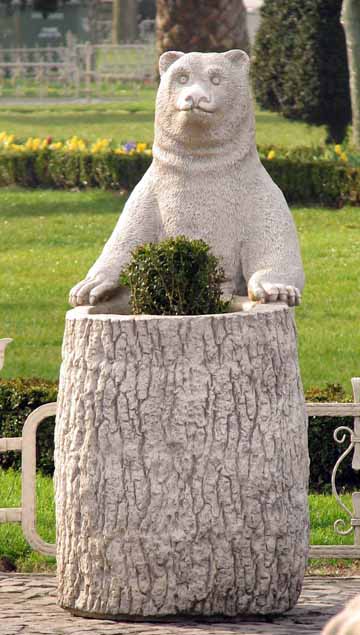
And Fountains!

And we see the Blue mosque for the first time, but walk by for the time being.
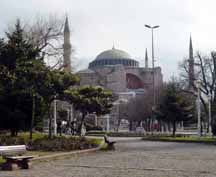
But - before we go there, we see several pieces of history found in the park.
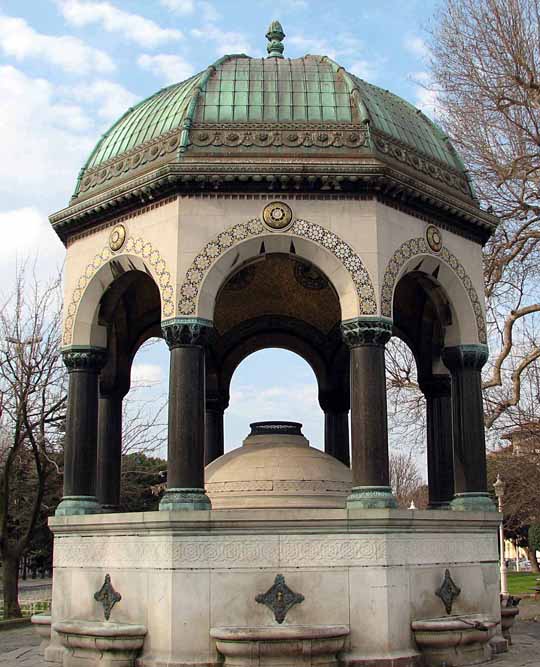 This
fantastic piece of work was in the park.
This
fantastic piece of work was in the park.
I never learned what it was or why it was there. As this is the first mosaic work I saw, it knocked my socks off. I took a number of pictures and one became my favorite of the entire trip.
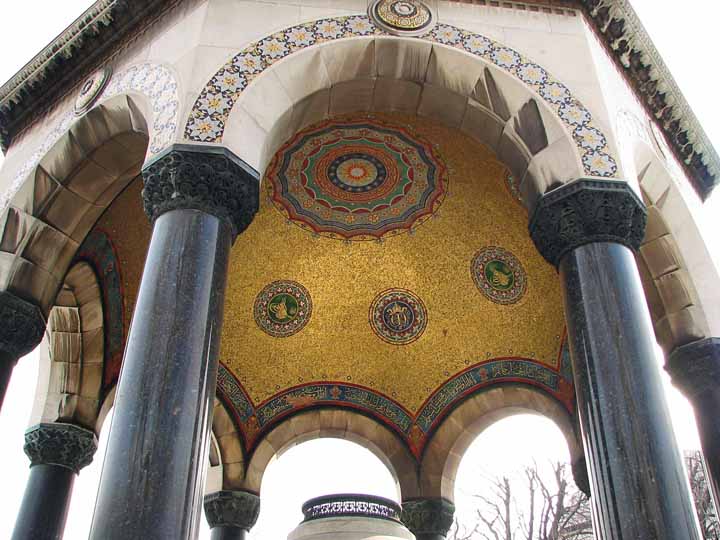

The Egyptian Obelisk was built in 1500 BC and stood outside Luxor until Constantine brought it here. It appears to now be only 1/3 its original size. The base was built in the 4th century and depicts Theodosius l and his family.
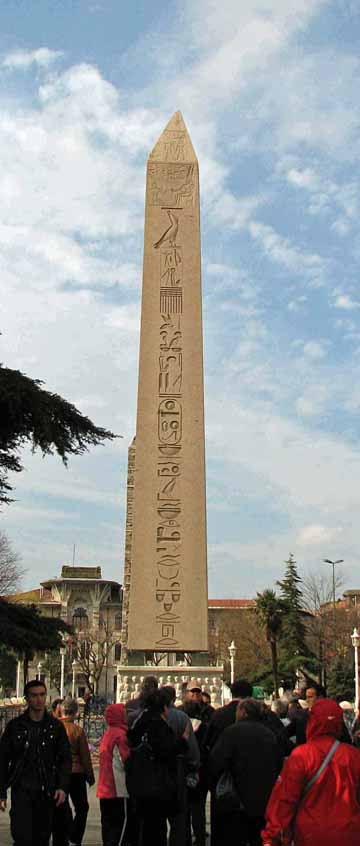
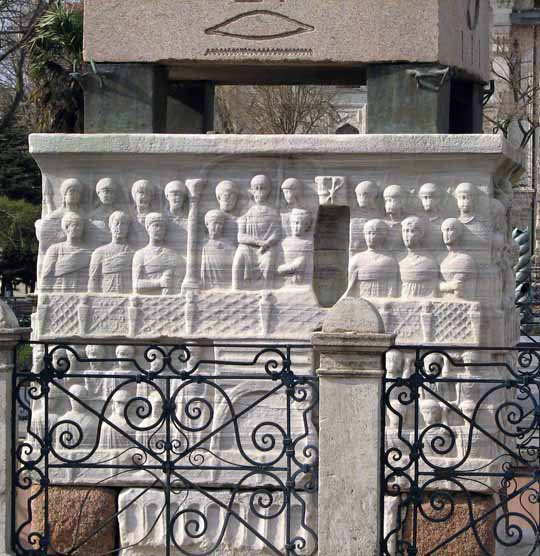
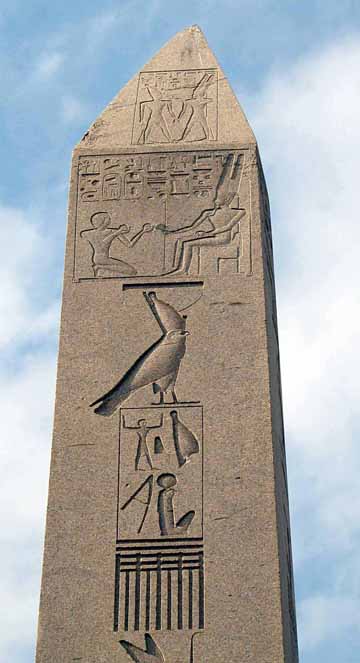
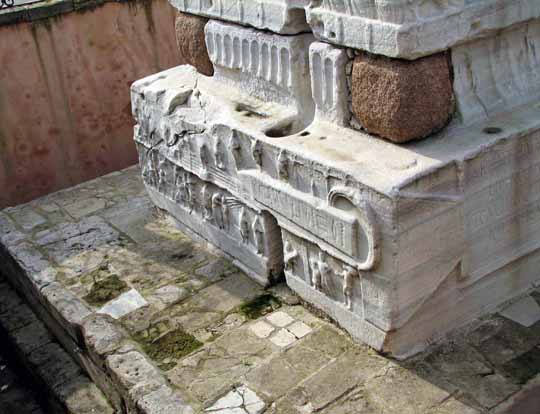
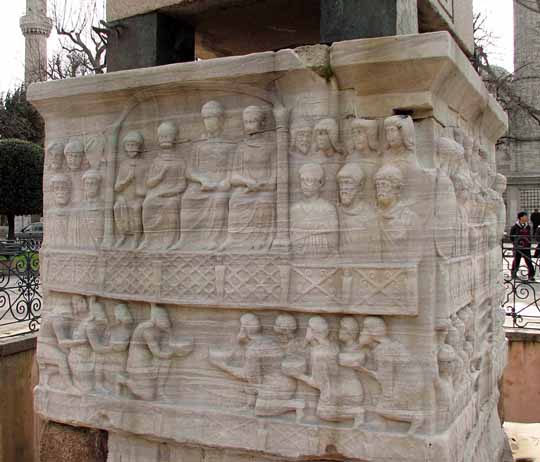
The Serpentine Column dates back to 480 BC - The heads of the serpent were knocked off by a drunken Polish nobleman. (tourist?) The plaque tells the reason for the column.

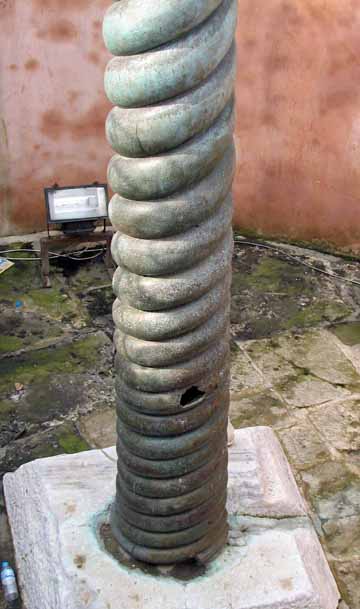
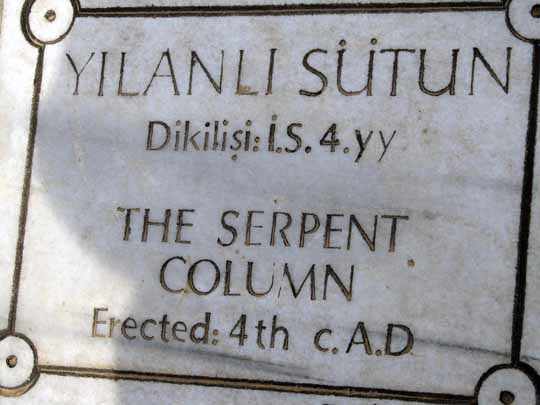
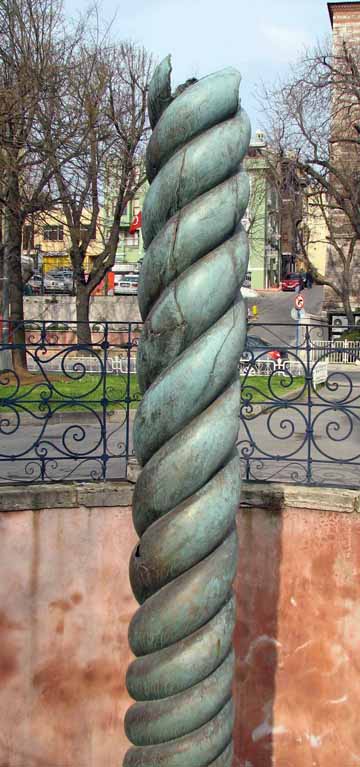
The Column of Constantine Porphyrogenitus has no known date. It was reconstructed by Constantine in the 10th century. It was sometimes called the Brazen Column because at one time it was sheathed in bronze. Part of the wear on the column is because for centuries, young men would test their bravery by climbing the column.
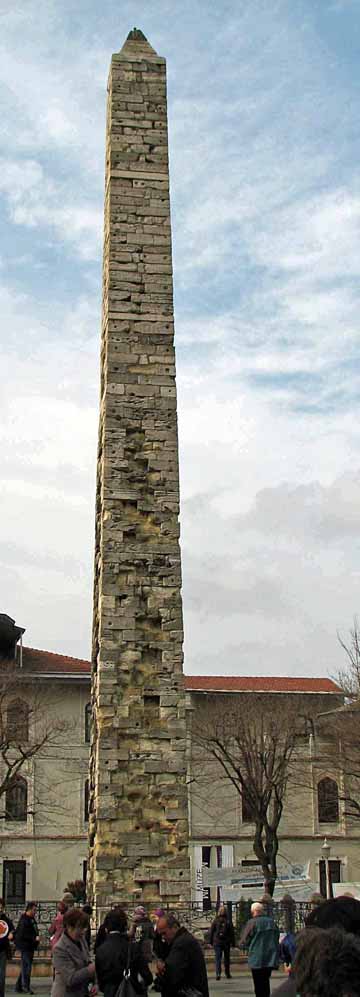
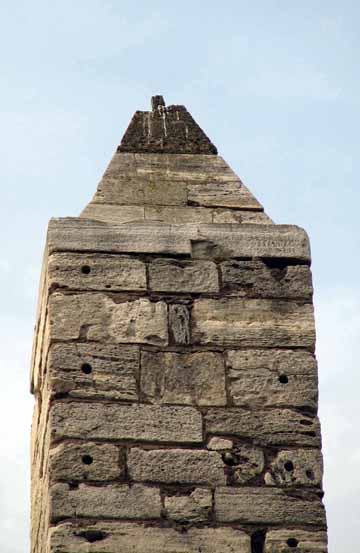
The Hippodrome - the ground where we walked and saw these works, was the scene of one of the bloodiest events in Istanbul's history. In 532 a brawl between rival chariot teams developed into the Nika Revolt. Much of the city was destroyed. The end of the battle occurred when mercenary troops under the command of Justinian's General Belisarius massacred an estimated 30,000 people trapped in the Hippodrome.
Blue
Mosque
The
Sultan Ahmed Mosque (Sultanahmet Camii;
is a historical mosque in Istanbul, the largest city in Turkey and the capital
of the Ottoman Empire (from 1453 to 1923). The mosque is popularly known as the Blue Mosque for the blue tiles
adorning the walls of its interior.
It
was built between 1609 and 1616, during the rule of Ahmed. Like many other
mosques, it also comprises a tomb of the founder, a madrasah (madrasah
literally means a place where learning/studying is done) and a hospice. While
still used as a mosque, the Sultan Ahmed Mosque has also become a popular
tourist attraction.
The mosque was to be built on the site of the palace of the Byzantine emperors, facing the Hagia Sophia (at that time the most venerated mosque in Istanbul) and the hippodrome, a site of great symbolic significance. Large parts of the southern side of the mosque rest on the foundation and vaults of the Great Palace
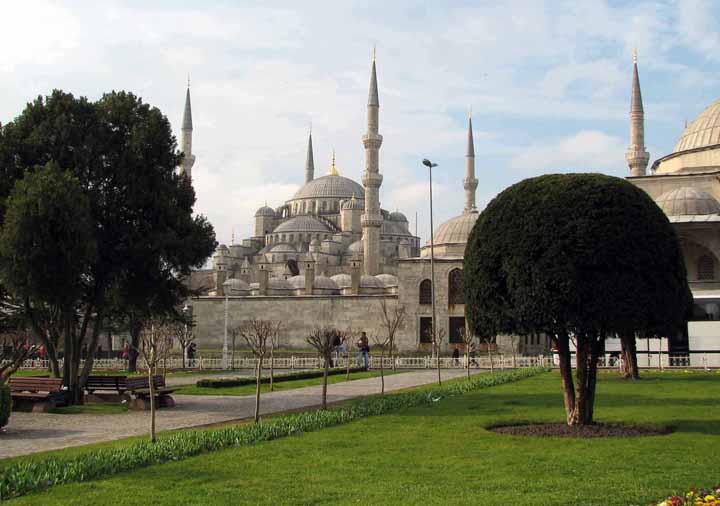
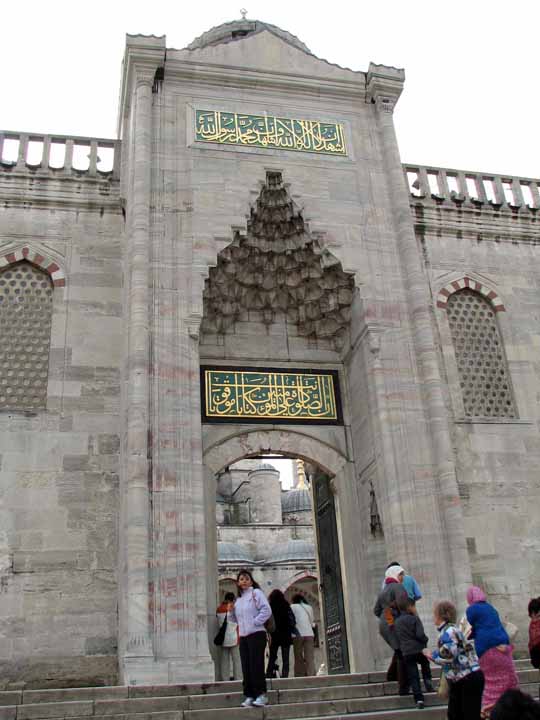 The
street entrance
The
street entrance
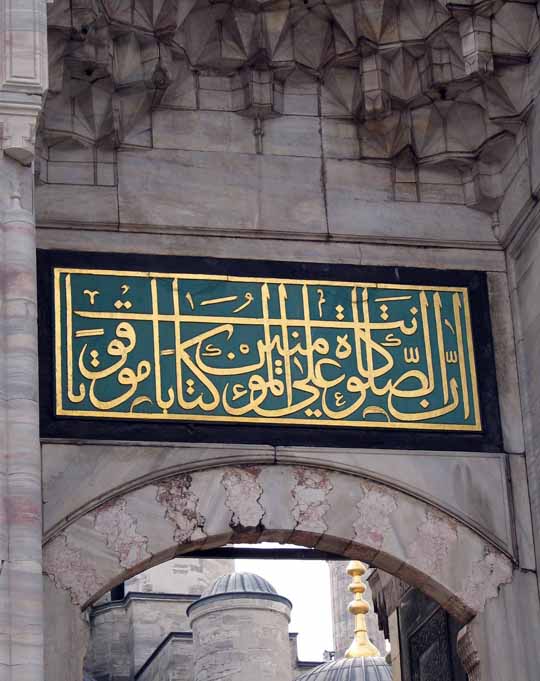
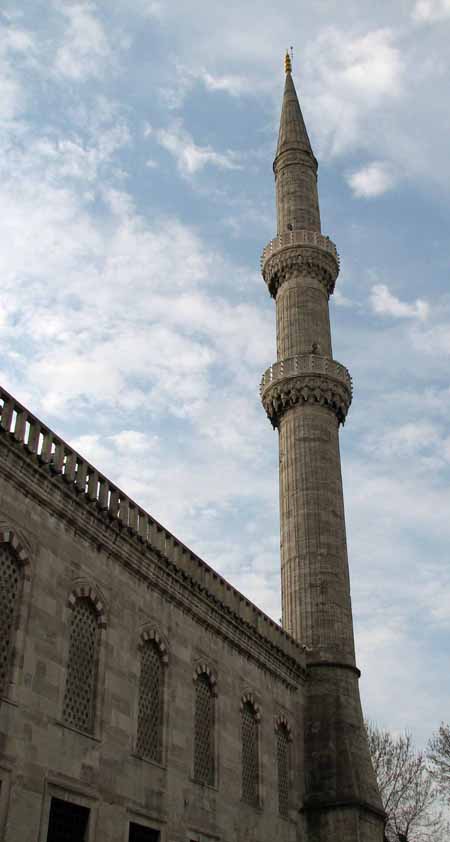
Over the entrance One of the six minarets
 The
street gate
The
street gate
View through the entrance

After entering, looking up (ignore my fingers shading the camera)
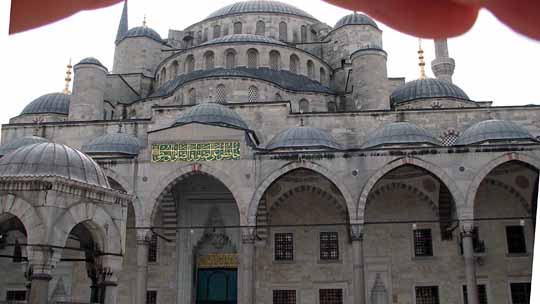
Top of a minaret
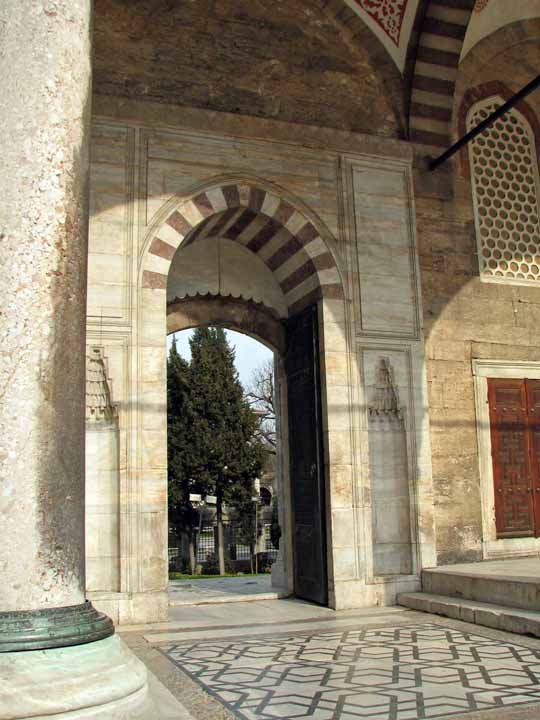 A
side entrance
A
side entrance 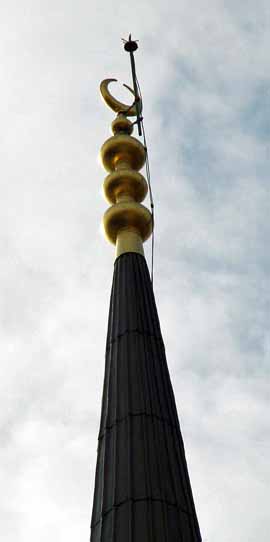

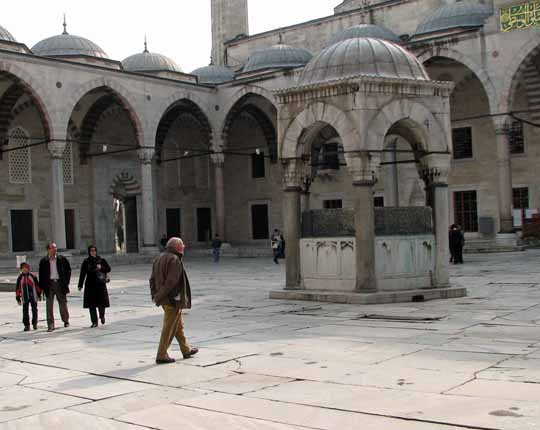
Over the walkway A fountain outside
 Beautiful
calligraphy
Beautiful
calligraphy
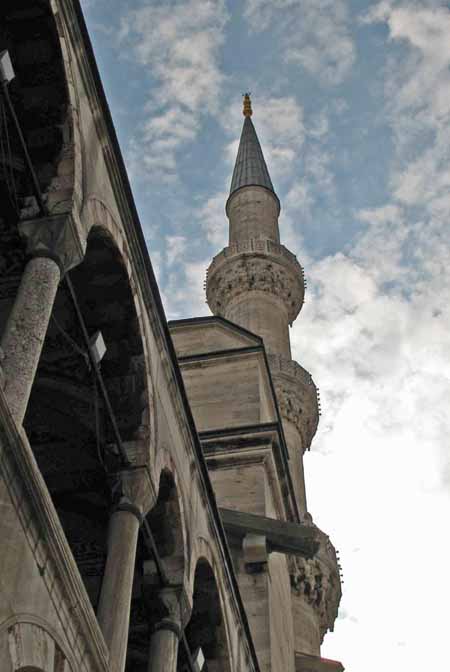
The Blue Mosque is called "blue" in reference to all the blue mosaic inside. It is a working mosque and we were to not wear shoes and behave appropriately while inside. The floor seems to go on for acres because there is noting but open space covers with an immense rug. You'll note the wires hanging down and, to my mind, "interfering" with taking pictures. This is because the mosque has no windows per se, and would be very dark if it were not for literally hundreds of lights hanging on retainers from the ceiling. I simply could not imagine what it would have taken to keep those hundreds of lights working when they were oil lamps.
The dome of the Blue Mosque - I was in awe
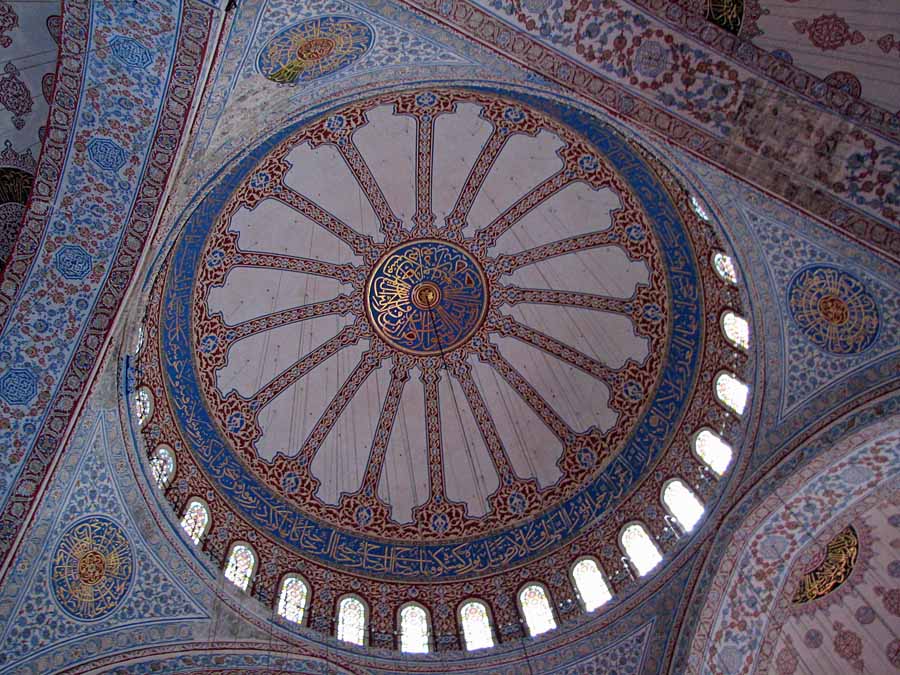
The main pillar - I don't recall it's circumference - but its is huge.
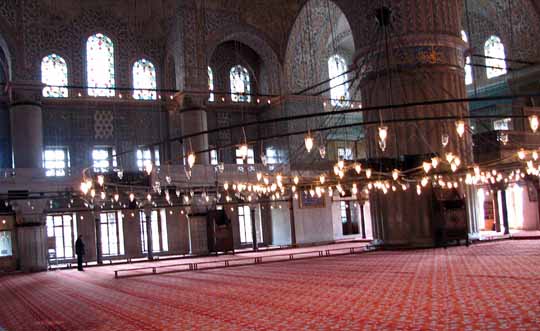
I'll not "talk", and just show pictures.........

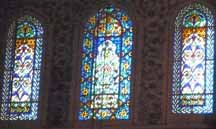



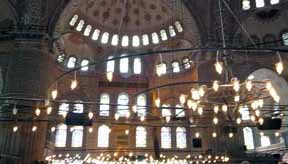
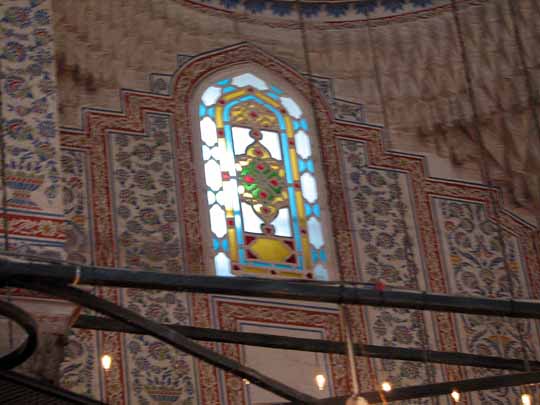
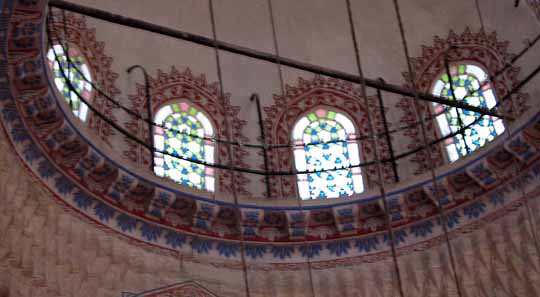
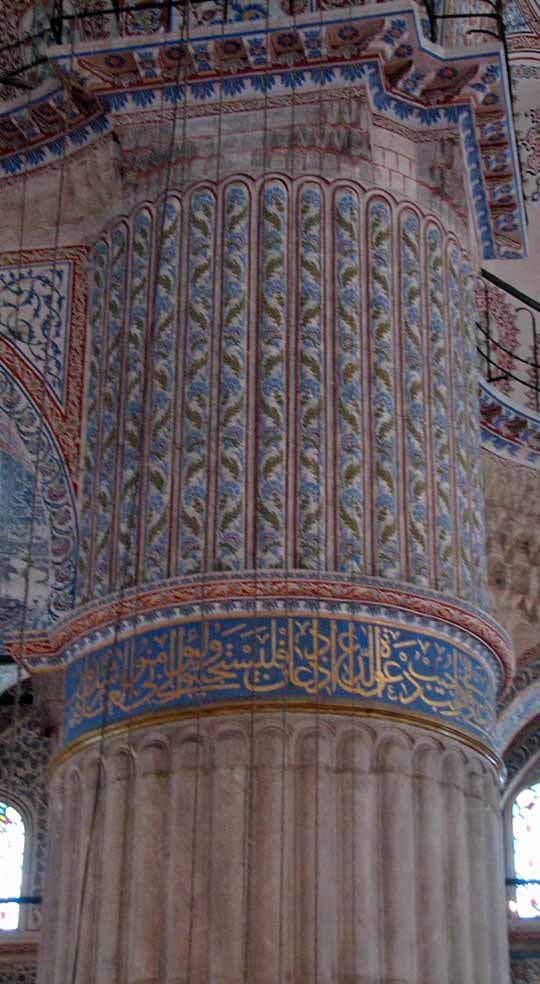
OK - I can't shut up - This is breath taking !!
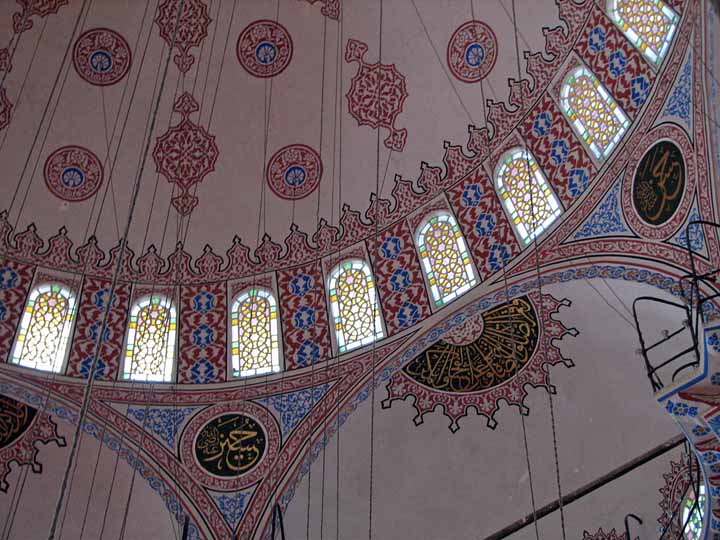
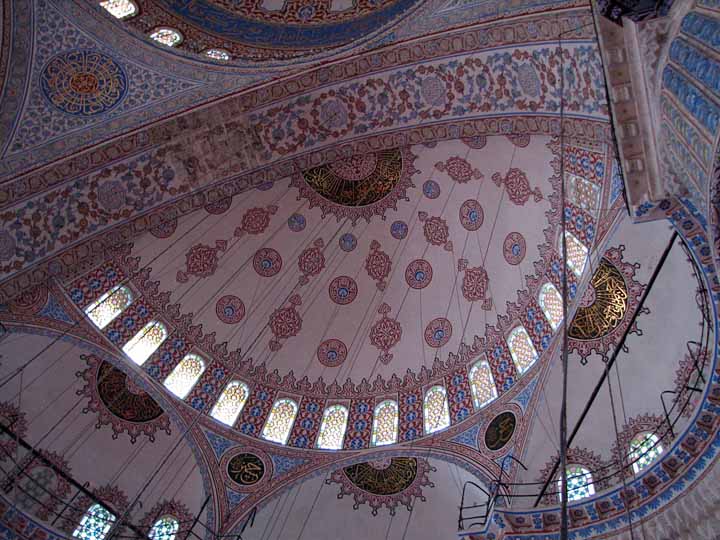

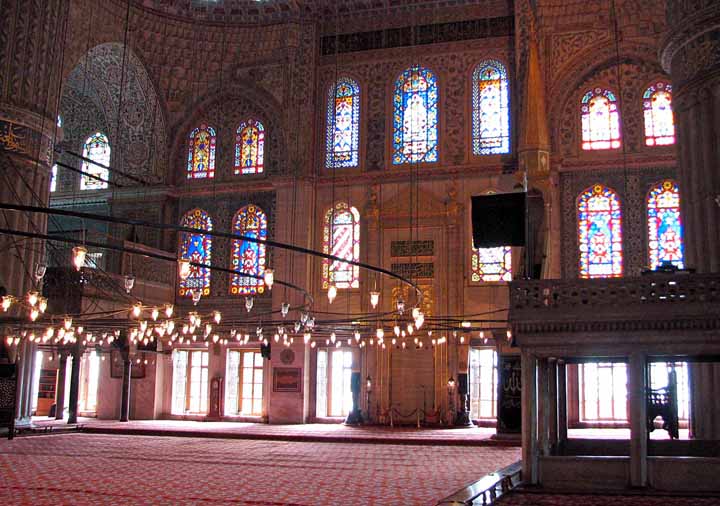
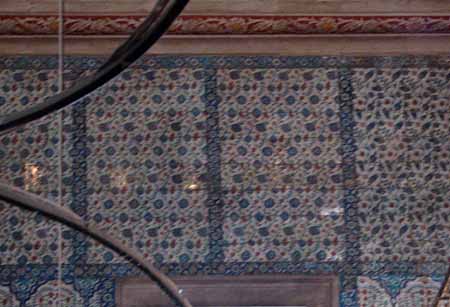
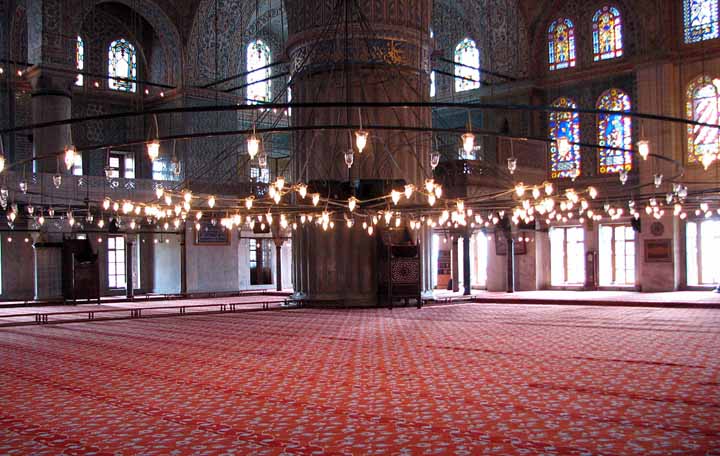
There are no images in Mosques - only fantastic calligraphy
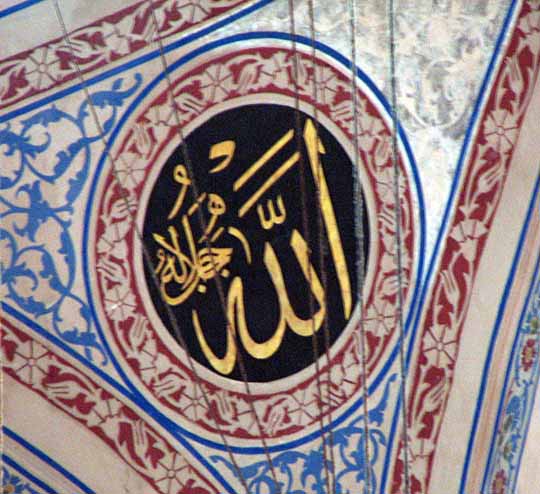
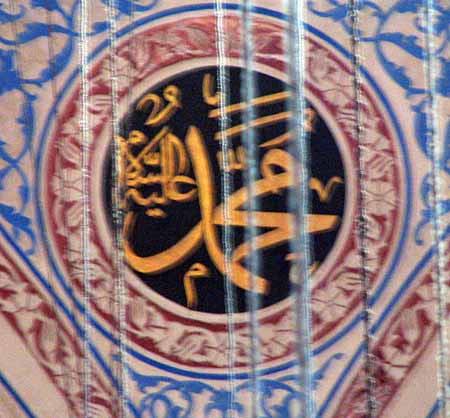
Calligraphy for Allah Calligraphy for Mohammed

My favorite wife
The colors of the minerals in the columns
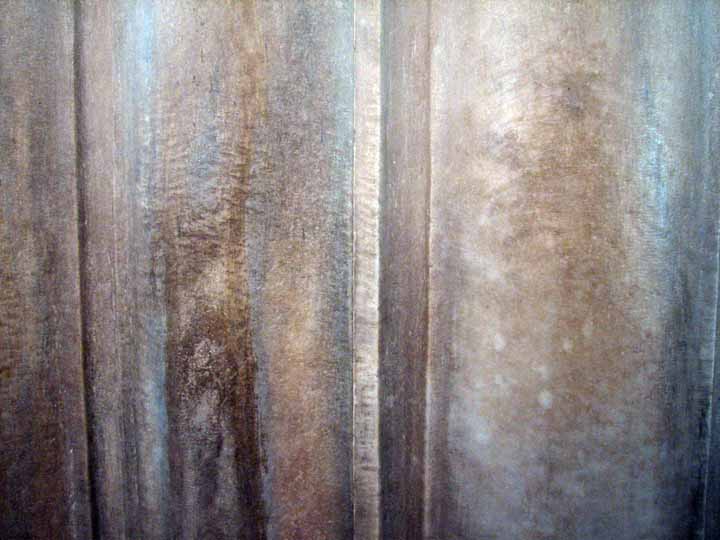
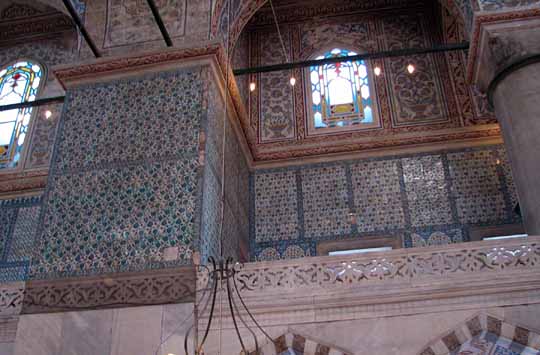
Some more of the blue mosaics that named the Blue Mosque.


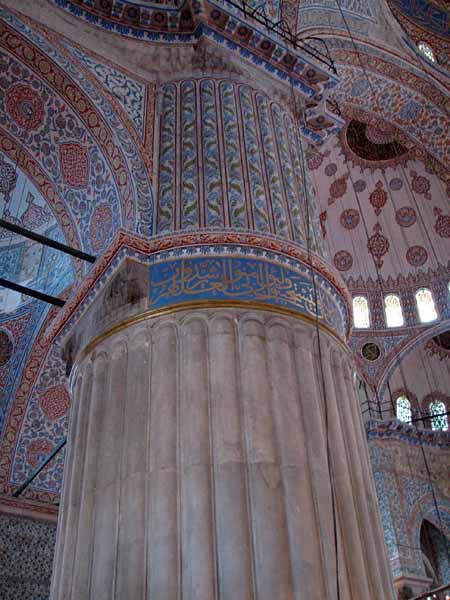
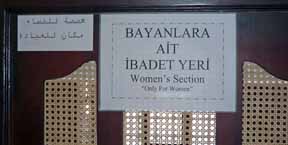
A separate section for women
And we look back as we walk away - however - as you will see in other pictures, it appears you see the Blue Mosque in the background where ever you go.





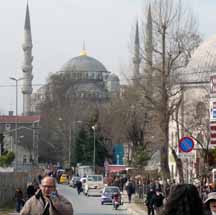
Hagia Sophia
A
former Byzantine church and a mosque, The Church of the Holy Wisdom is known as
'Hagia Sophia' in Greek, 'Saint Sophia' in Latin and 'Ayasofya' or 'Aya Sofya'
in Turkish. Hagia Sophia has a trail that dates back to 532-537 AD. The monument
is unique in its existence - having a base of both Christianity and Islam
·
Hagia Sophia remained the largest cathedral in the
world for a span of thousand years, until the construction of Medieval Seville
Cathedral in 1520.
·
The existing structure dates back to 532-537 AD. It
was built on the instruction of the Byzantine Emperor Justinian.
|
For
1000 years, the monument served as the patriarchal church of the Patriarch
of Constantinople and the focal point of the Eastern Orthodox Church. | |
|
It
was in 1453 that Constantinople was conquered by the Ottoman Turks.
Following this, Sultan Mehmed II ordered the building to be changed into the
Ayasofya Mosque. | |
|
The
transformation of the church into a mosque caused the removal of bells,
altar, iconostasis, and sacrificial vessels. Eventually, many mosaics were
plastered over again. | |
|
Under
the rule of the Ottomans, Hagia Sophia attained Islamic features, such as
the mihrab, the minbar, and the four minarets outside. | |
|
Hagia
Sophia remained the principal mosque of Istanbul for about 500 years. |
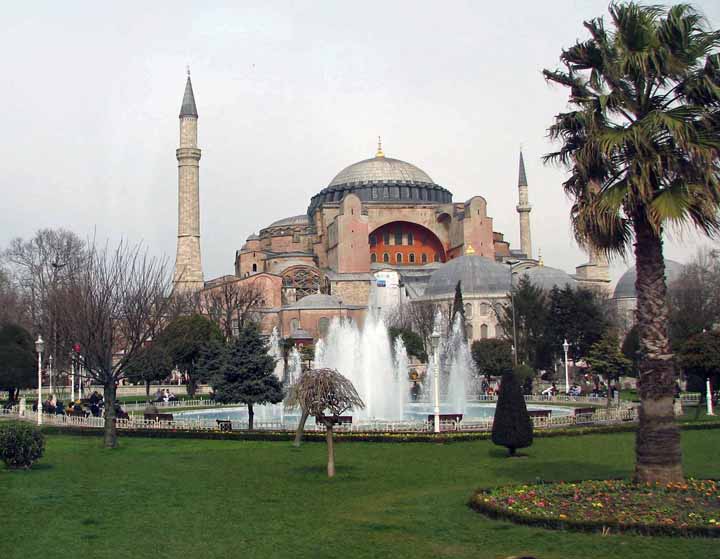
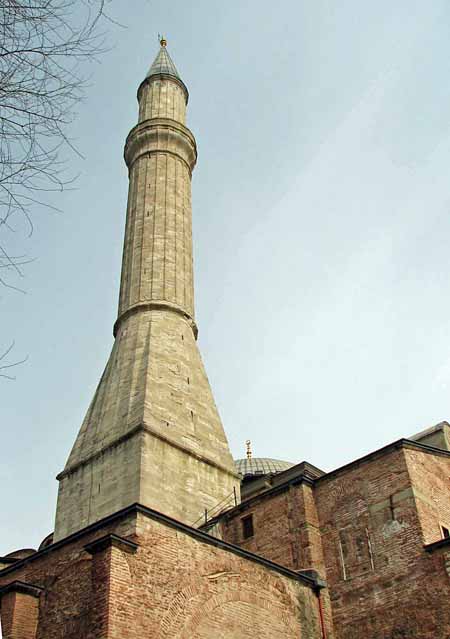
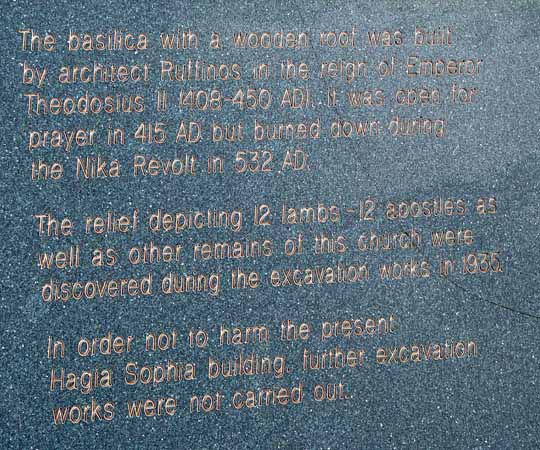
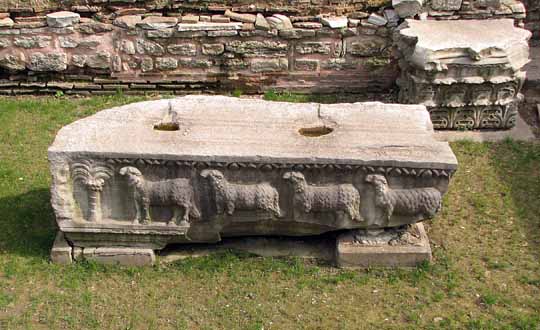
The lambs are clearly part of the original Hagia Sophia as are the low walls surrounding then. Also part of the original Hagia are some of the walls in the background. As the notice says, to protect what is left of the Hagia, no additional excavation is allowed.

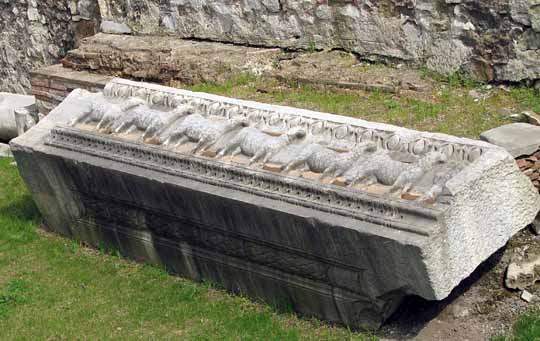
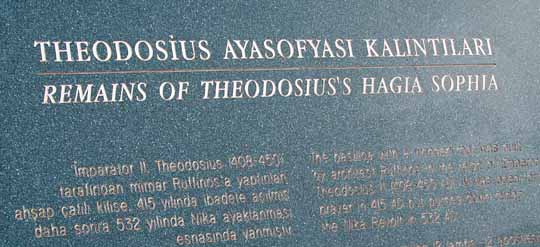

During the Byzantine, the exonarthex, above, was reserved for those who had not yet been baptized. Doors to the minarets added in the Ottoman era, are found at the northern and southern ends.
A crusader crypt. Remember, the Hagia was a Christian center for the Orthodox church for hundreds of years prior to becoming a mosque.
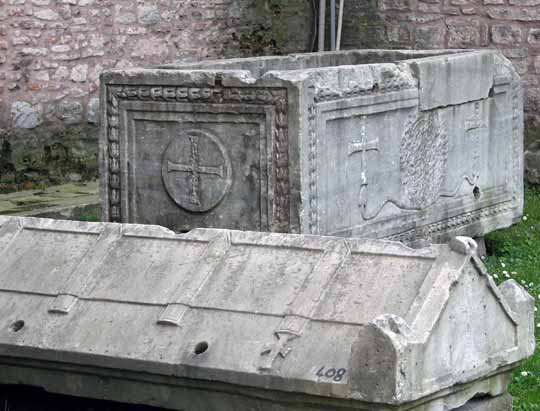
Some of the fantastic archs made of individual bricks.
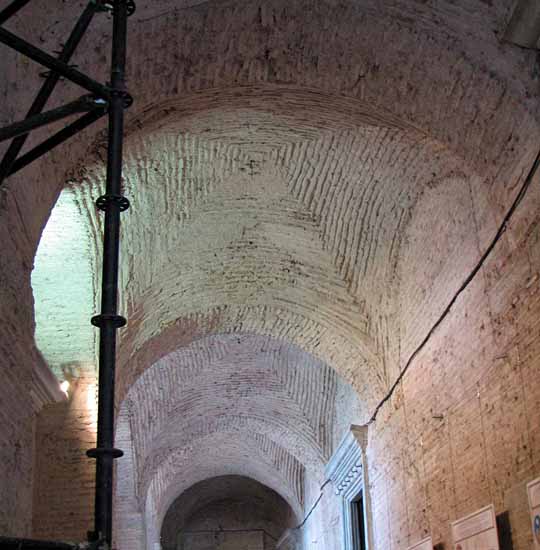
The mosaic figures are unique in the world. After the defeat of the Christians, the Hagia was taken over to be a mosque. Because no figures are allowed in a mosque, the mosaics would have been destroyed, except for the Koran. Because Jesus and Mary are prominently mentioned in the Koran, rather than being destroyed, out of respect, Muslims plastered over the mosaics.
After the Hagia was made a museum, the plaster was removed to reveal the fantastic mosaics. Certainly, a gift to the entire world.
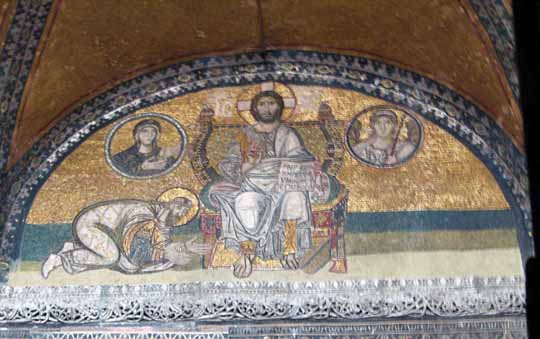
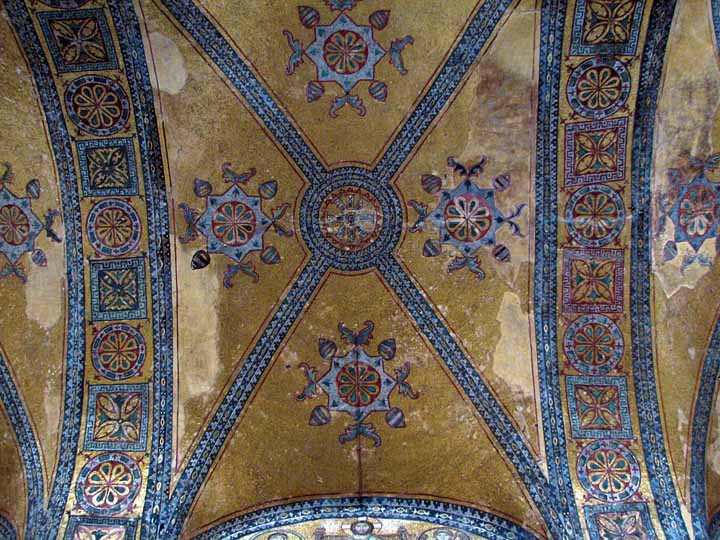
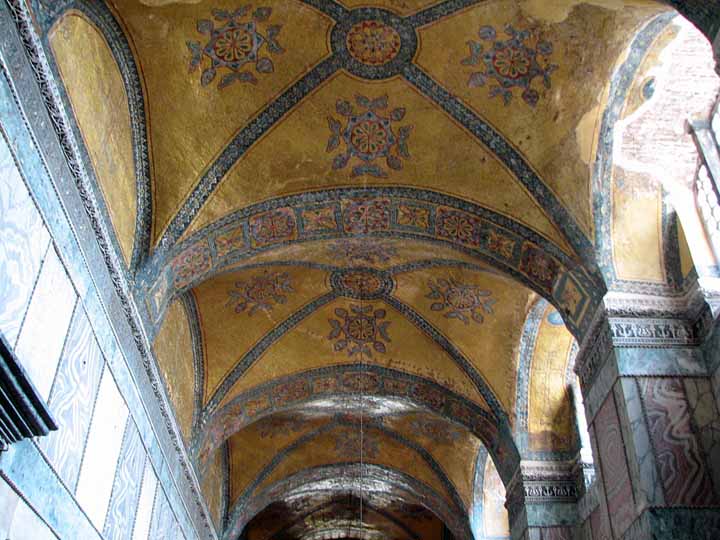
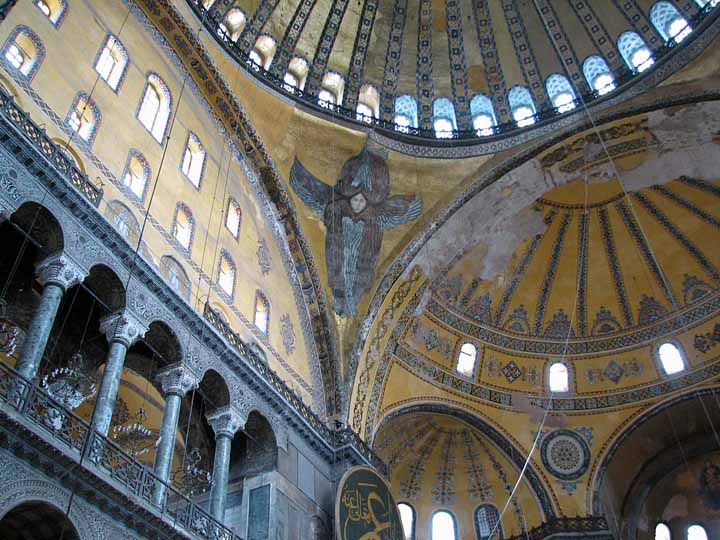

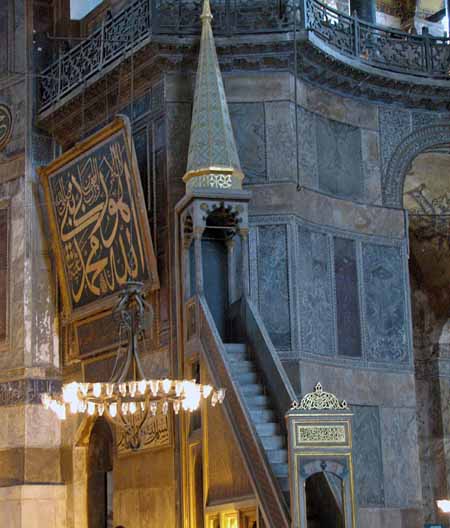
The place from which the imam speaks.
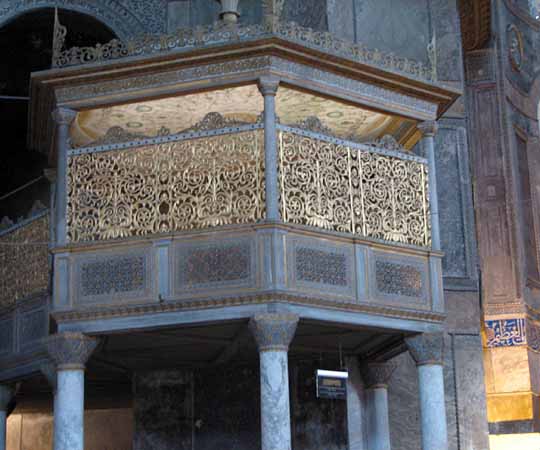
The special box for the Sultan and his family prayed. They are elevated well above floor level and the screen is supposed to gave no holes in the lattice work large enough for an arrow to penetrate.
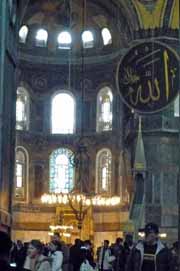

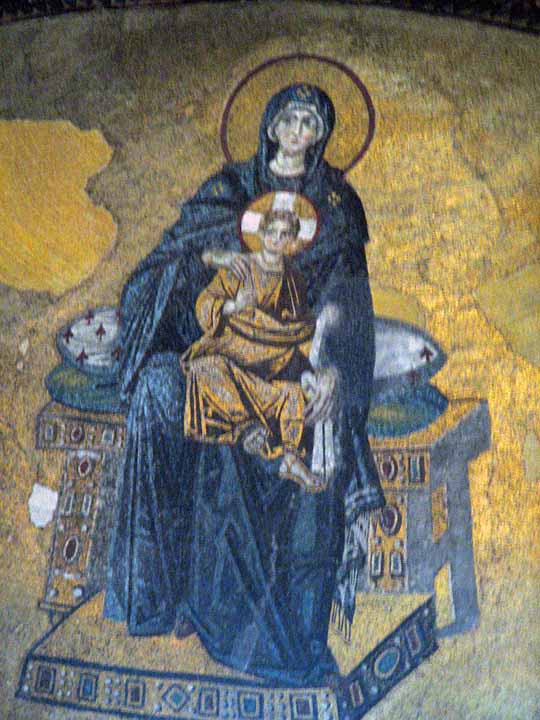
Allah Mohammad
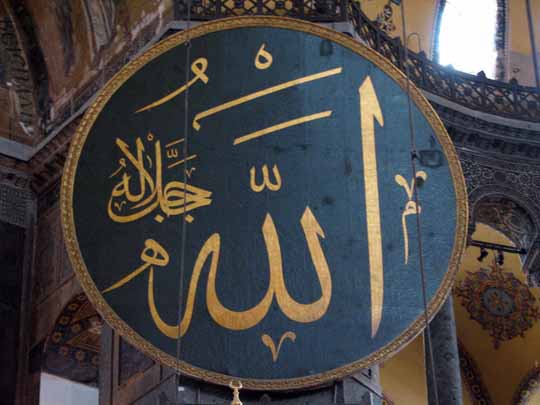
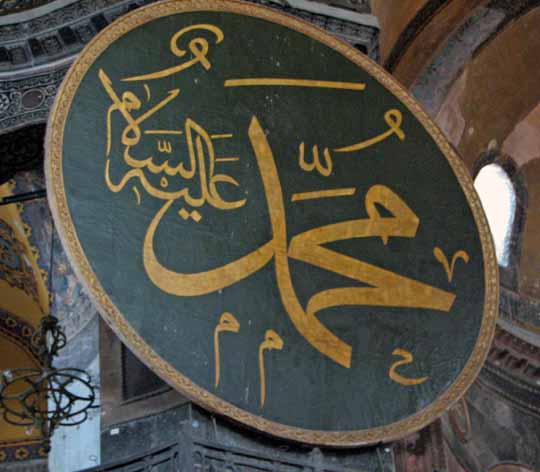
One of the strangest scenes one will ever see - Mohammad, the Virgin Mary holding the Christ Child, and Allah - all in one place, on one wall.

Again, from a very slightly different angle - too remarkable for just one shot.
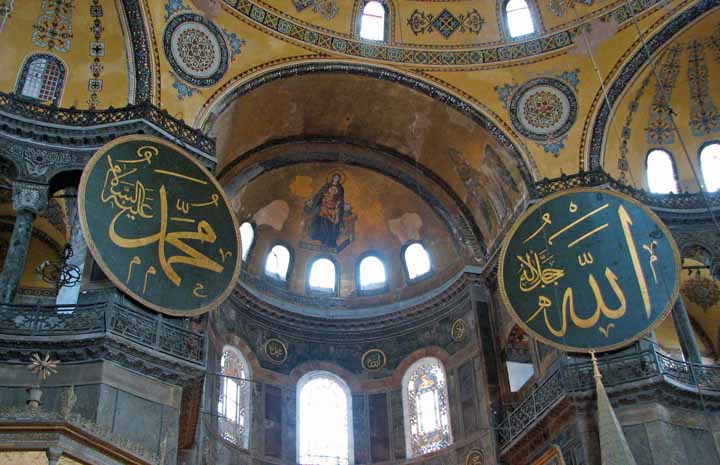
Some of the fantastic stone carving on the pillars.
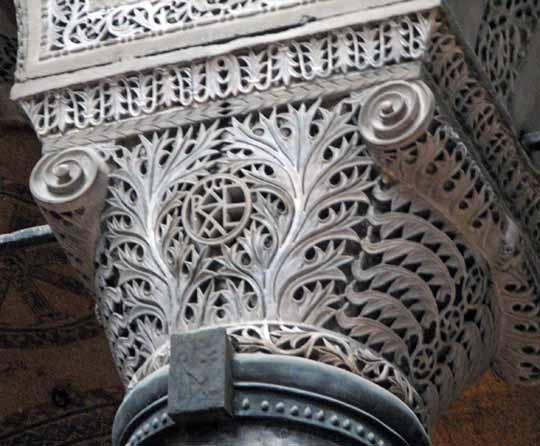

The most important of Hagia Sophia's 107 columns are located on the ground floor. Some of these were brought from ancient temples and monuments in different regions of the empire.
Historical sources agree that they were acquired from the Temple of the Sun god Heliopolis, from the Temple of Artemis in Ephesus, and from monuments in Rome and Baalhek.
The nave of the church is in the center, but to the left (and I missed a good picture) is where the mosque focal point is. While the nave is centered on the East, the mosque is centered on Mecca - and in this case, they were were about 15 feet different form one another.
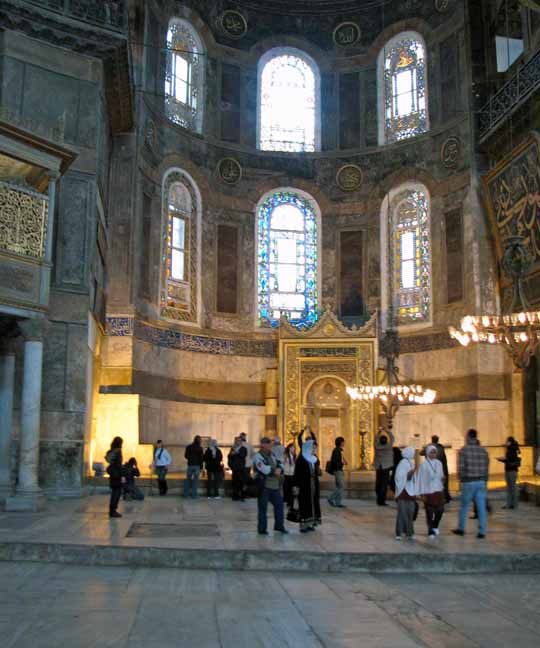
In the south-eastern end of the church, stands a rectangular column on which there is a hand print. There were many legends about this hand print. As the sources indicate, this piece of stone was added later onto the column. It was originally found in the Theotokos Church at Ayvansaray and the hand print was accepted as the Virgin Mary's. When the church burned down, the stone was brought to Hagia Sophia
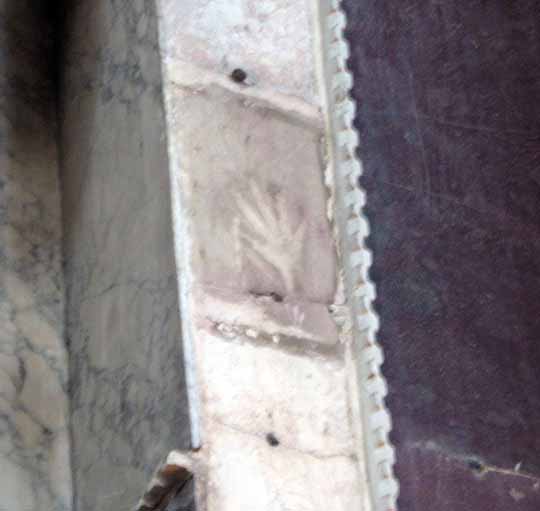
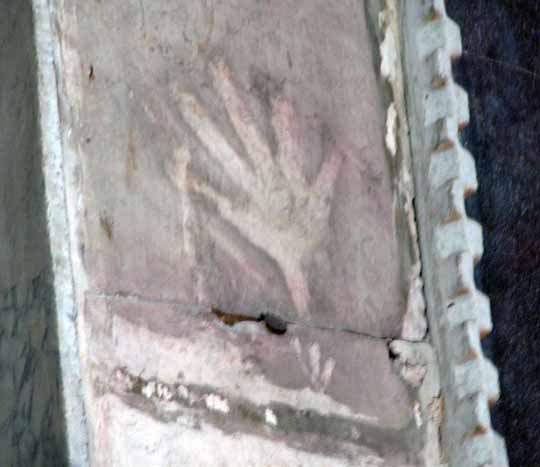
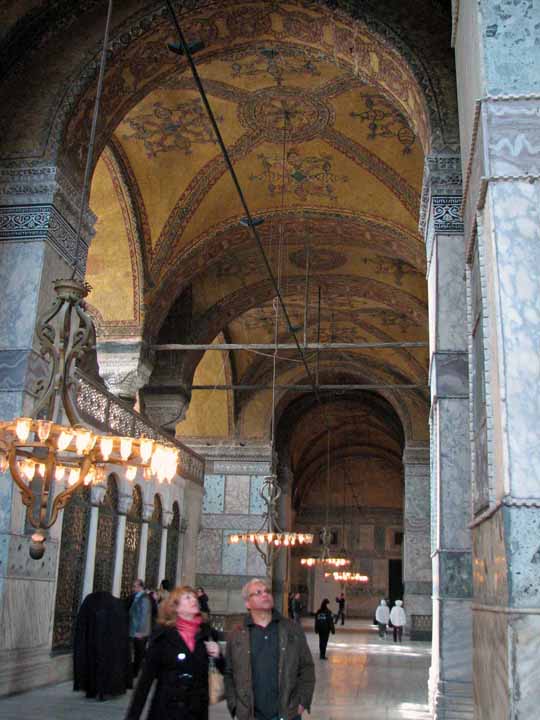
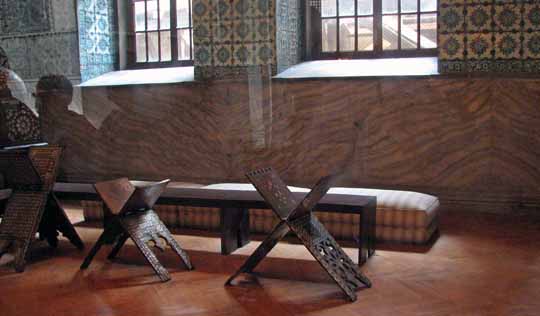 A
study area.
A
study area.
 Some
of the truly grand mosaics.
Some
of the truly grand mosaics.


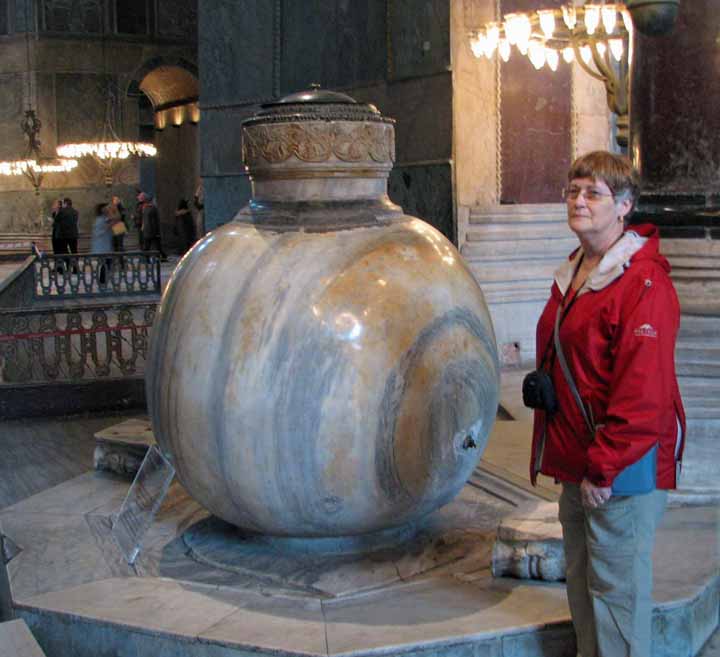
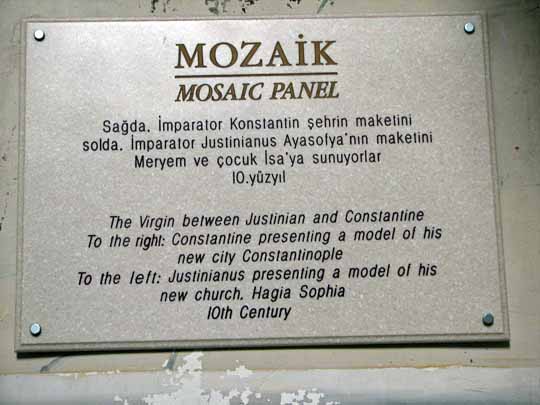
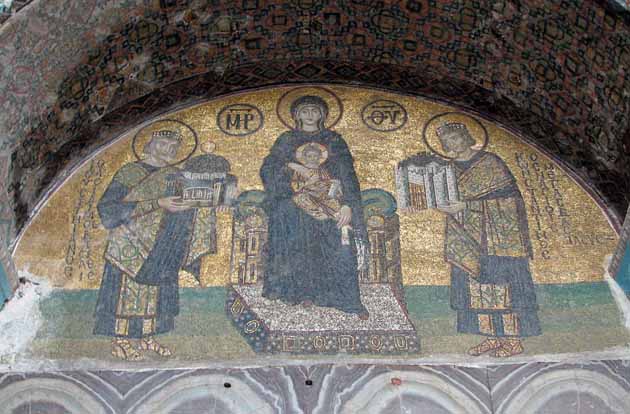

Because the mosaic panel is over a door as one walks out, most people never see it. To solve this the Hagia has installed a large mirror opposite the panel above the exit's outer door. Below is the "mirror image" of the panel pictured above. Notice the reverse cause by the mirror.



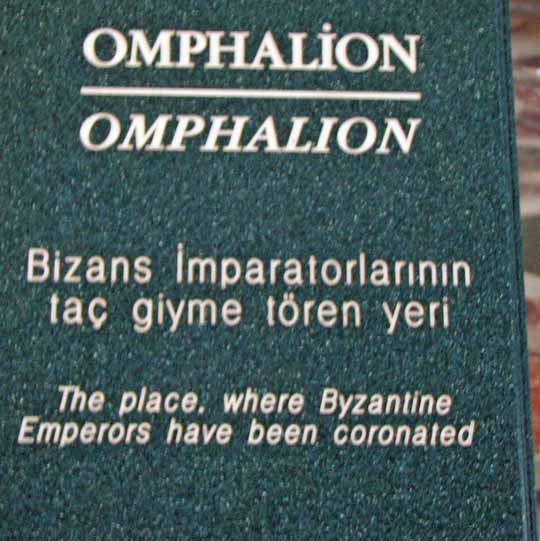
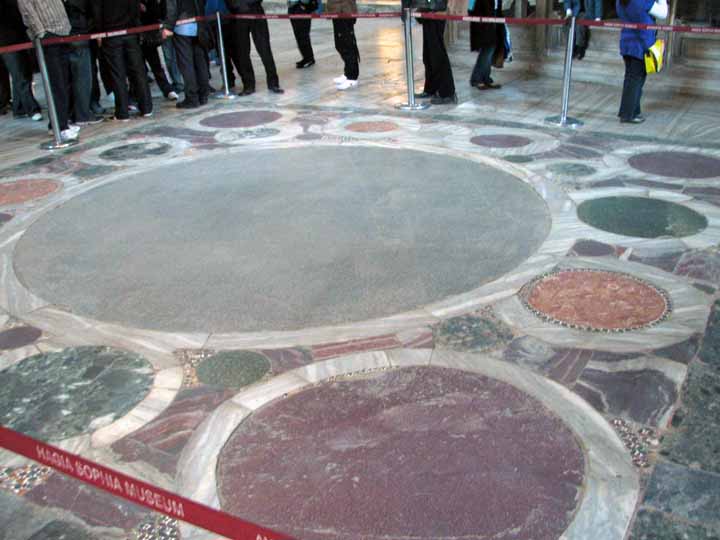

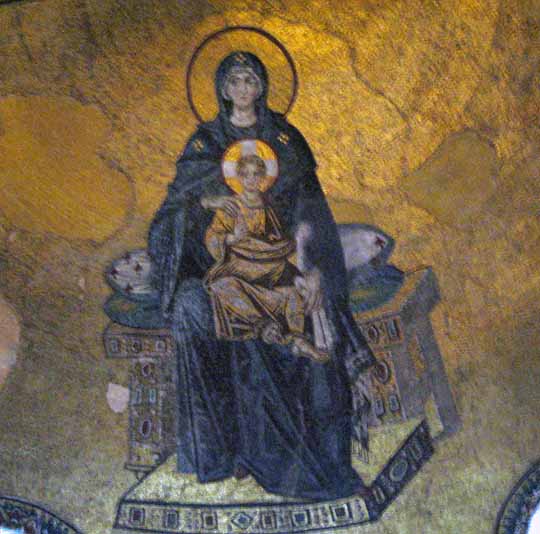

The front of the mosque - pointing towards Mecca.
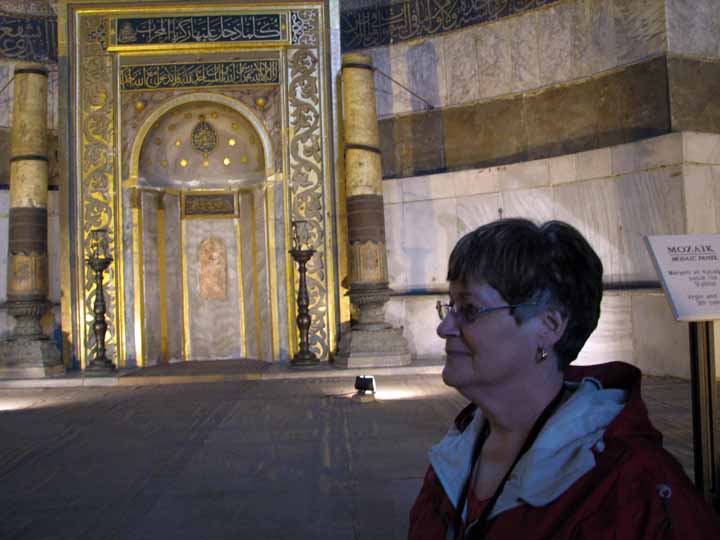
 More
mosaics
More
mosaics

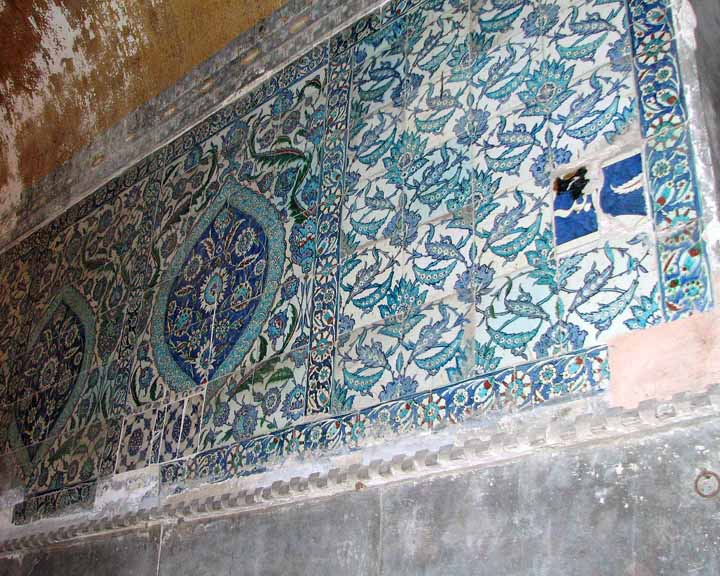
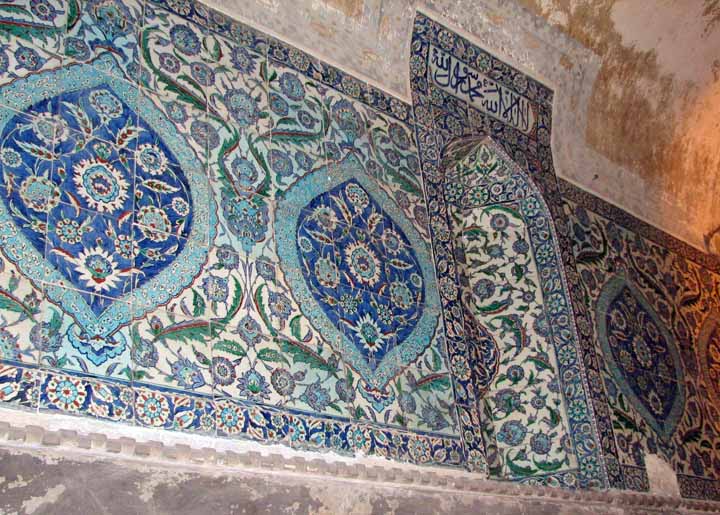



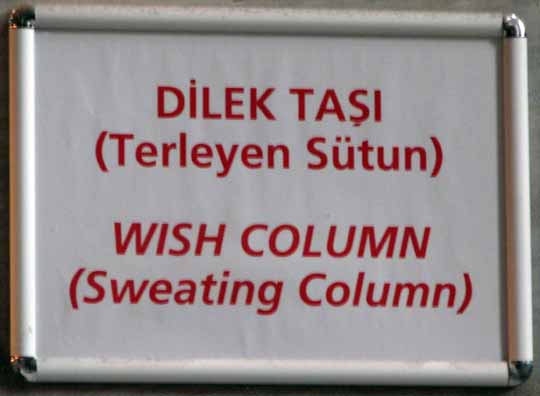
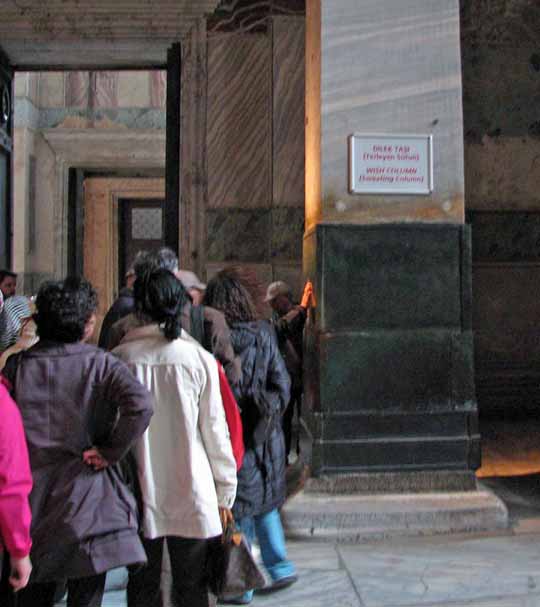
Visitors wait in line to place a finger or thumb in the hole in the Sweating Column to bring them good luck.
Experts still work on protecting the Hagia Sophia
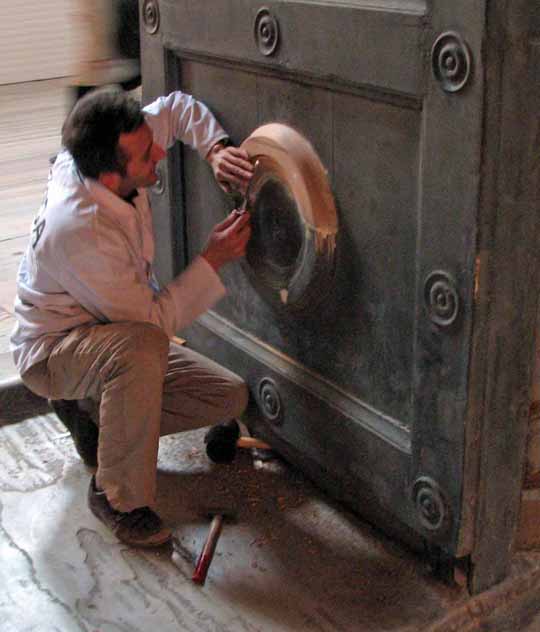
The Serpent Bowl.

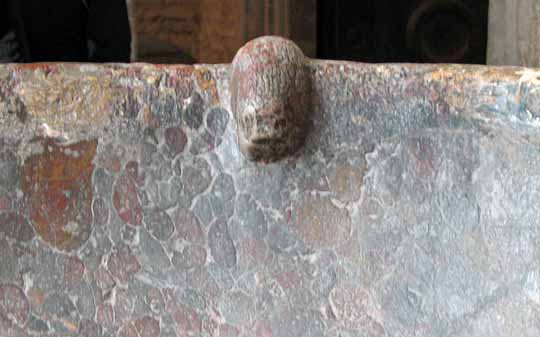

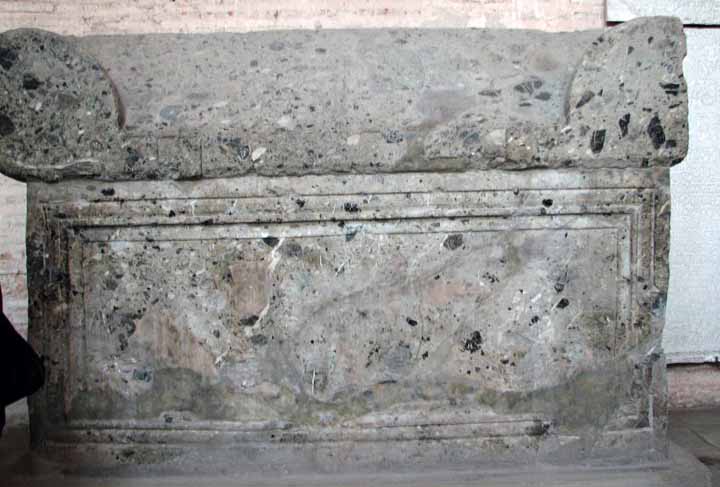
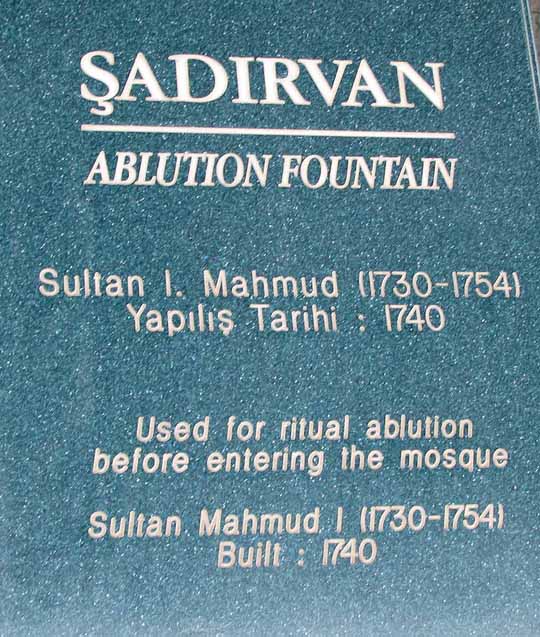
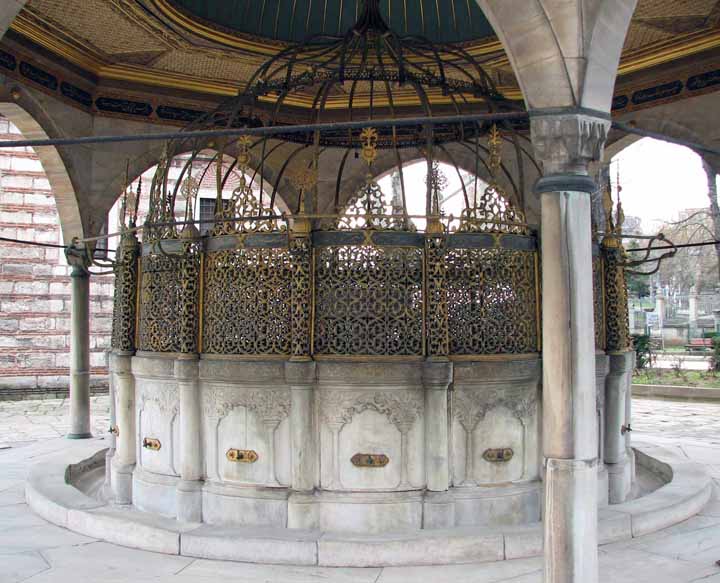
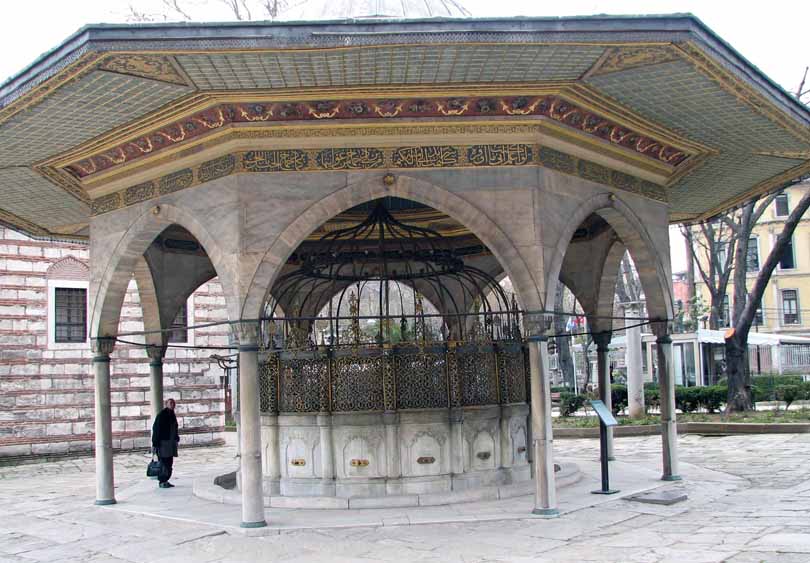
And we leave this one of a kind religious museum.
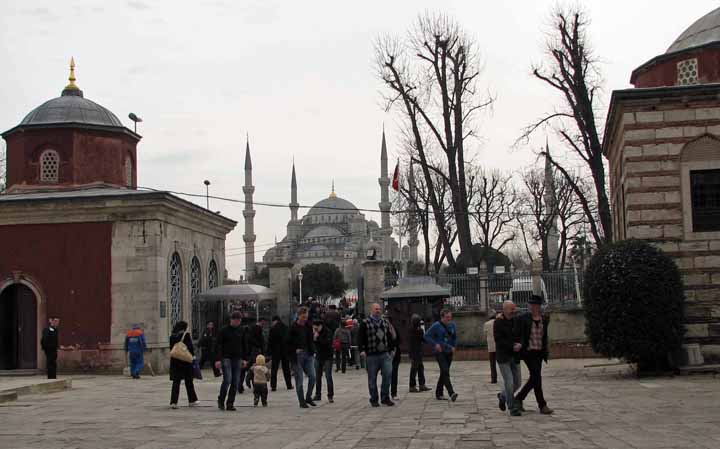
Oh, Jackie & I has been told by earlier visitors to Turkey to bring cat treats. We brought five containers and ran out of treats long before we ran out of places to visit. Here is one of our adopted pets at the Sophia Hagia.

Bascilica Cistern
The Underground Bascilica Cistern (or Yerebatan Sarayi in Turkish, meaning 'Sunken Palace') is a great underground chamber used in times of siege and is the largest and most beautiful Byzantine cistern of its kind of several hundred lying under the city of Istanbul.
Originally
built by the Byzantine Emperor Justinian in the 6th century after the Nika
revolt, it later became known as the Basilica Cistern during the Roman period,
as there was a Stoa Basilica above the pre-existing one at the time.
After the conquest of the city by the Ottoman Turks, it was forgotten of and nobody knew that it existed. Re-discovered in 1545, it was used to water the gardens of Topkapi Palace.
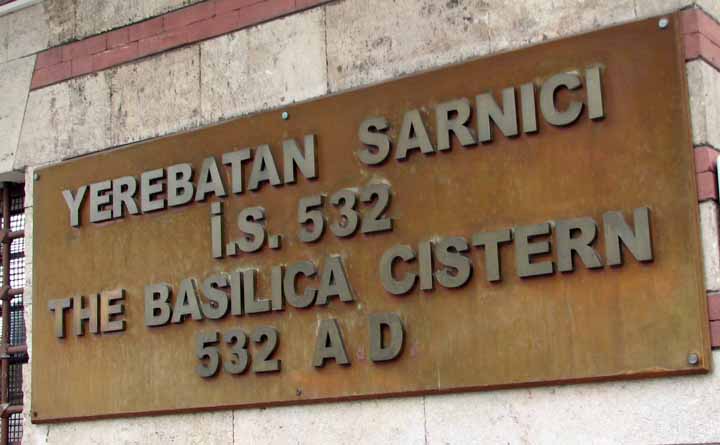
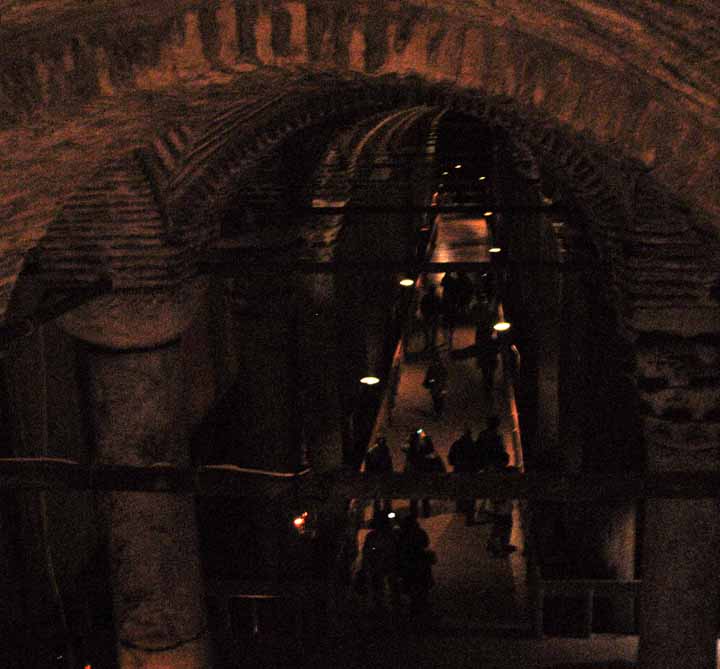
There is no way you can climb down into this water wonderland / cave / cathedral and not be overwhelmed - that is why it is a "must visit" for tourists. I took several pictures without flash to attempt to preserve the beauty of the lights playing off the arches, stone work and water. Oh - one needs to be prepared for 100 percent humidity and the uncomfortable, yet cool uncalculated air.
Below see more or less the same view with a flash - not anywhere as striking as the non-flash shot. However, as you will see, flash is appropriate if one wants to see details.

The lights on the columns were striking.

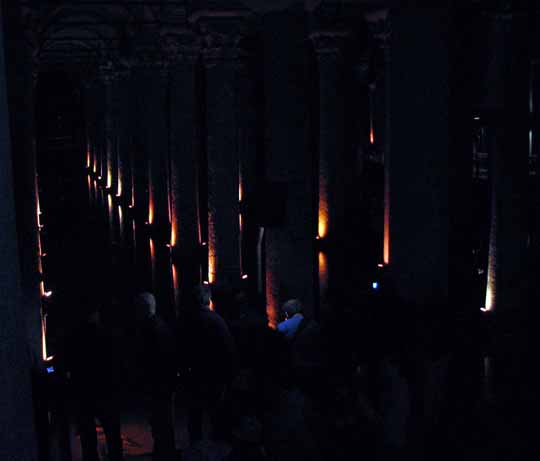
The brick work and the columns demanded light for detail
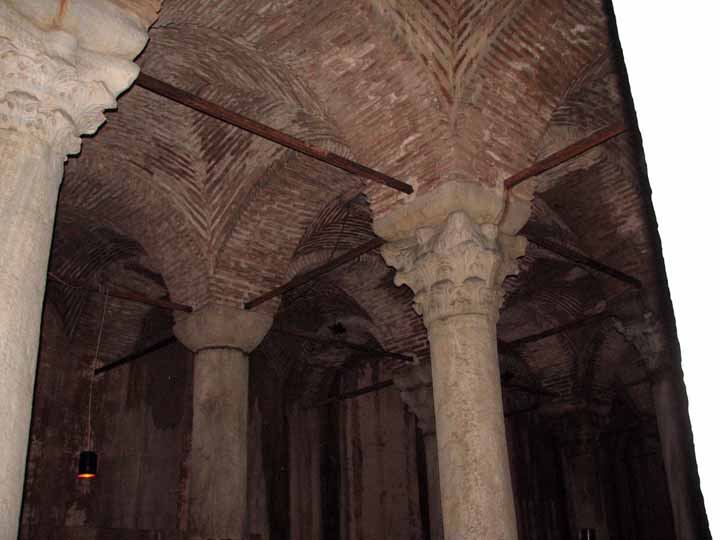
Love this shot
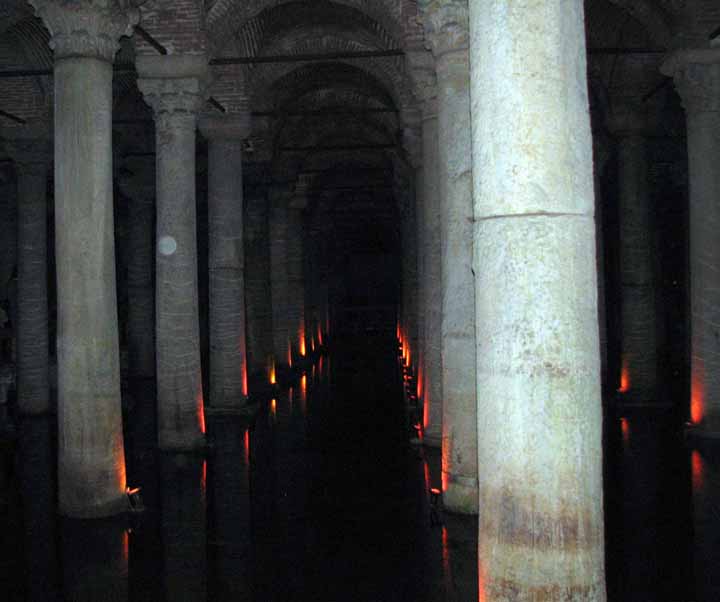
Yep - fish swimming in the water. Don't think I'd be tempted to drink from it however.
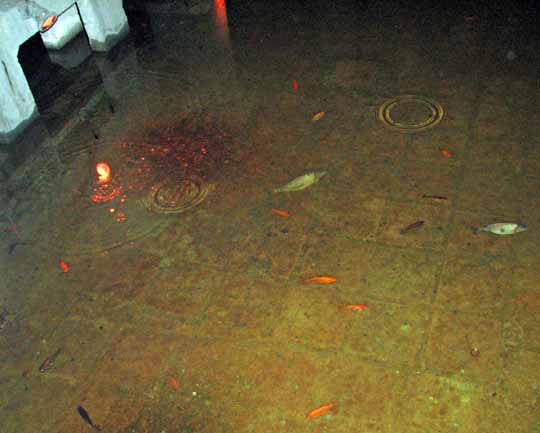
OK - more columns and such follow

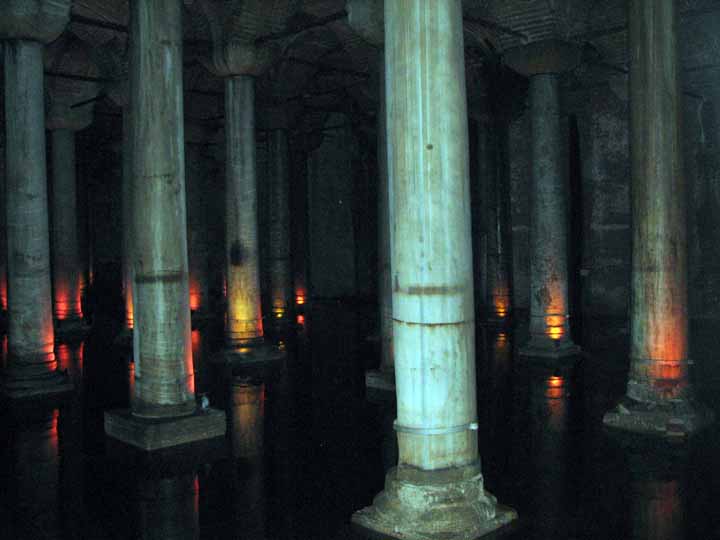
Remember the columns I told to to recall earlier? The columns, some of which remain
above in the parks, were "stolen / recycled" to provide columns for the cistern
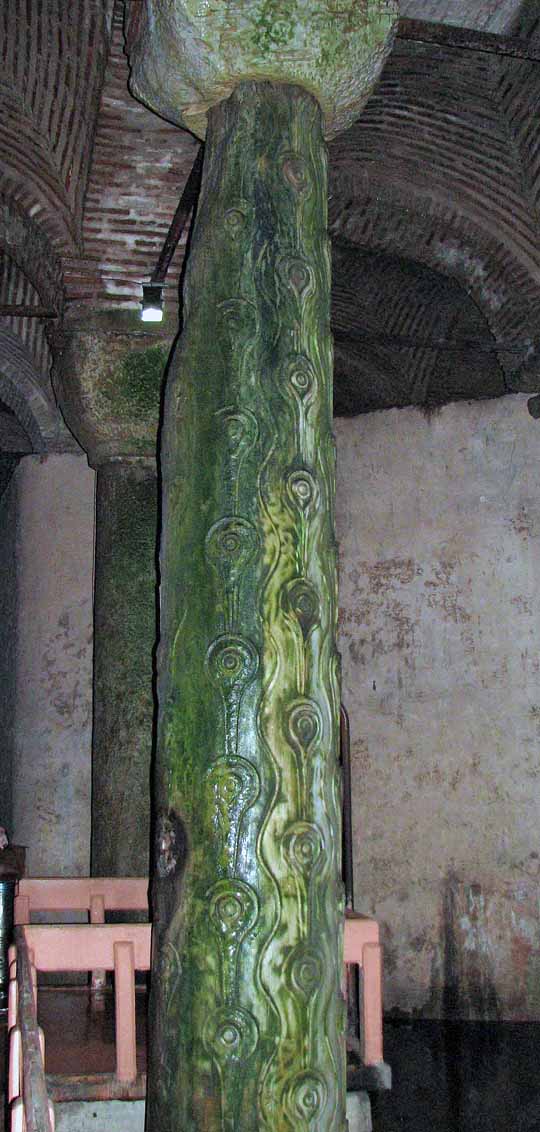
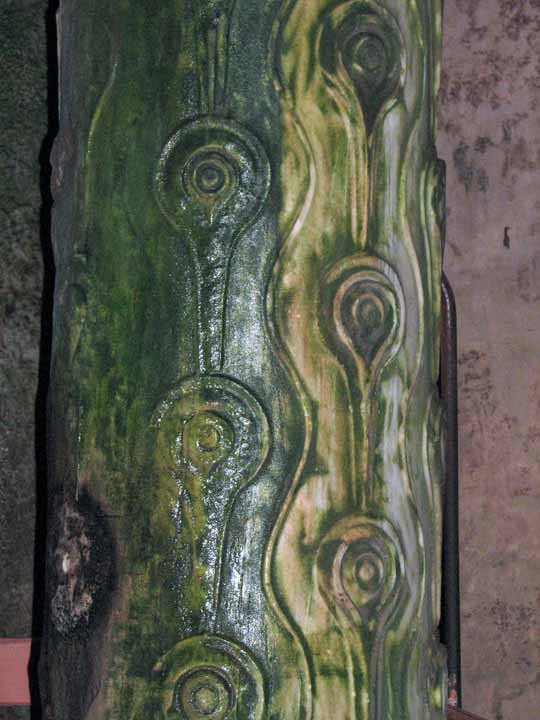
A close up of the tear drops.
And a review of the original columns that were "spared".

Yes, any ol' thing to make or hold the columns in place were "recycled", including the heads of women, such as this
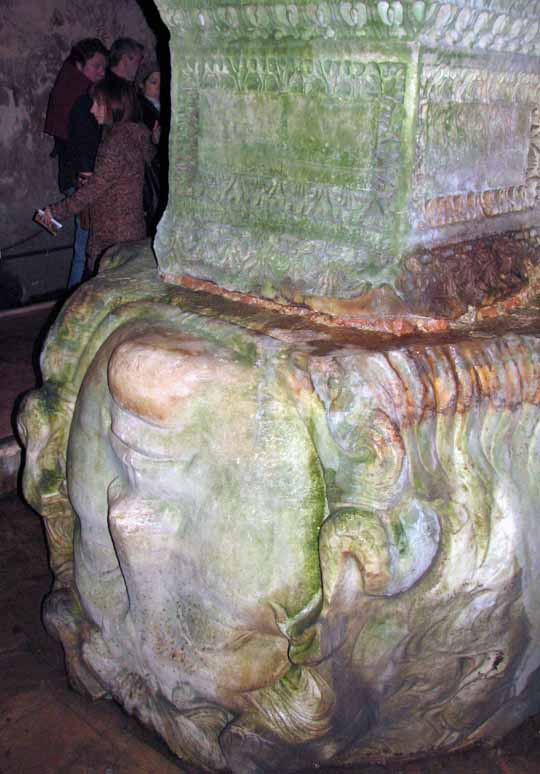


If I recall correctly, the head was that of Medusa. Oh, on the right, not the left!
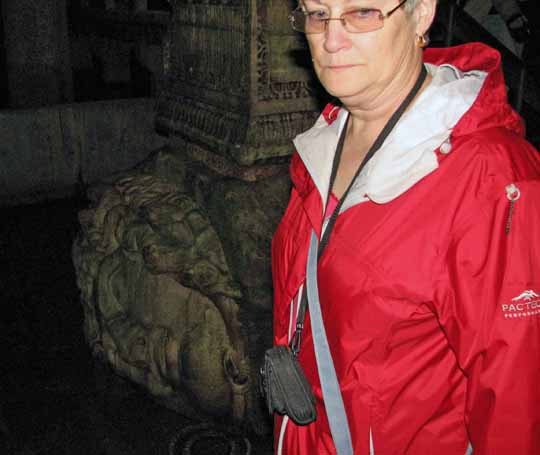
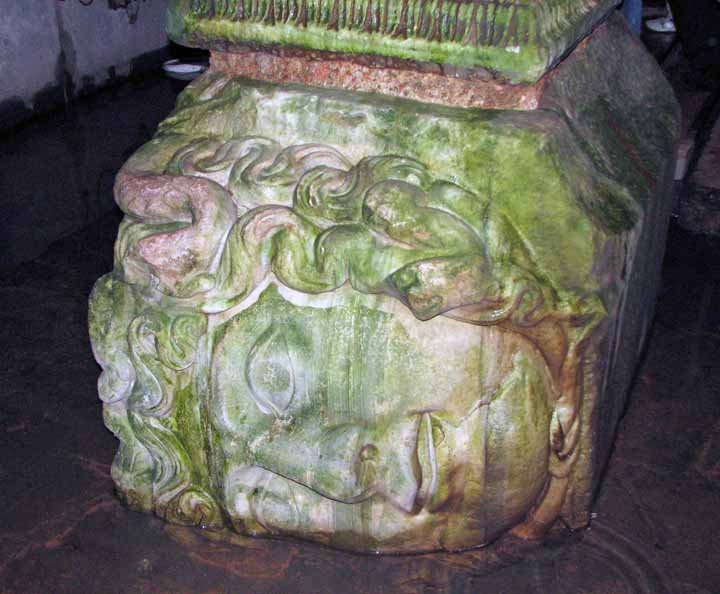
Topkapi
Palace
The palace was, to perhaps only me, a disappointment. I really didn't understand its place in the Istanbul environment or history. It was interesting however, as was the portions of the palace that are now museums. We got to see a number of famous items, including the silk kaftans of Mehmet the Conqueror, any number of gold items, historical Korans, and the famous Topkapi Dagger.
HOWEVER - there were what appeared to be 5,000 school kids there. They were not particularly interested in the palace displays, so they wandered as herds along the walls. This prevented us from seeing mush of what was displayed and I cannot find any good pictures. I'll keep looking....
When
Sultan Mehmet the Conqueror took Istanbul in 1453, he first ordered the
construction of a new palace for this new Ottoman capital, on a site in the
district of Beyazit where Istanbul University stands today. But before long, he
changed his mind and had a number of buildings constructed on the headland to
the southeast. This was to become the palace later known as Topkapi.
Apart from brief intervals, Topkapi Palace was home to all the Ottoman sultans until the reign of Abdulmecid I (1839-1860), a period of nearly four centuries. Over the years, the palace complex underwent constant evolution. Some buildings disappeared, destroyed by fire, earthquakes or demolished to make way for new buildings. The palace was therefore not a single massive building in the western tradition, constructed at one go, but an organic structure which was never static, and reflected the styles and tastes of many periods in many independent units with individual functions.

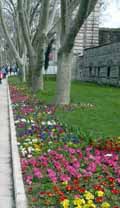
The entrance Flowers along the walk there.
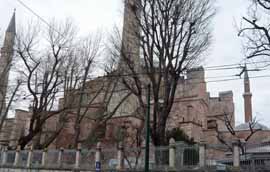 A shot from the street
A shot from the street
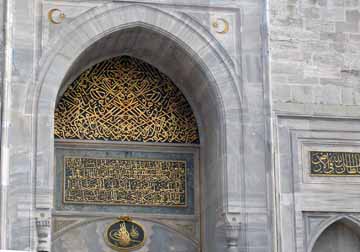

The ornate gold calligraphy over the main door - and yes, one could see the Blue Mosque in the distance.
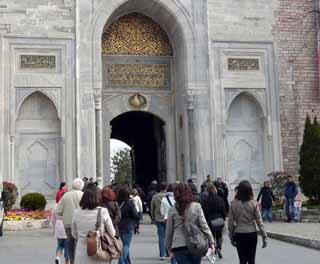
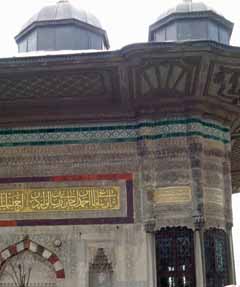
The colors of the calligraphy and the tiles were striking
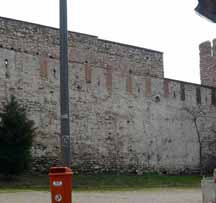 The
walls of the palace
The
walls of the palace
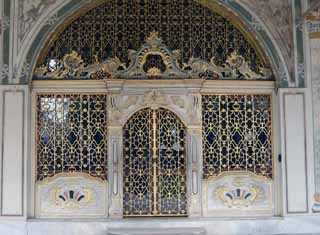

The gold covered iron work and again, beautiful calligraphy on the Imperial Council Wall
 The interior of the palace
The interior of the palace
 Forgot what this was...........
Forgot what this was...........
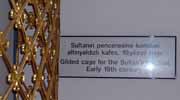
Although, due to my poor photography (more to come!)
the sign tells you this was the gilded window through which the Sultan could listen in secret to what was being said by those waiting to approach him.
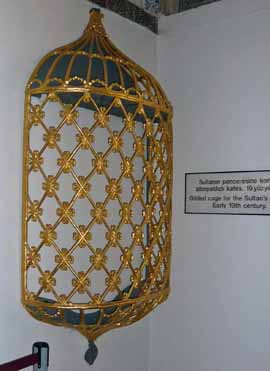
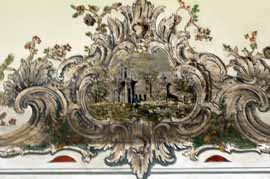 A
finely detailed painting on plaster over a door.
A
finely detailed painting on plaster over a door.

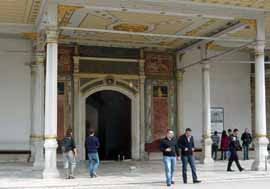
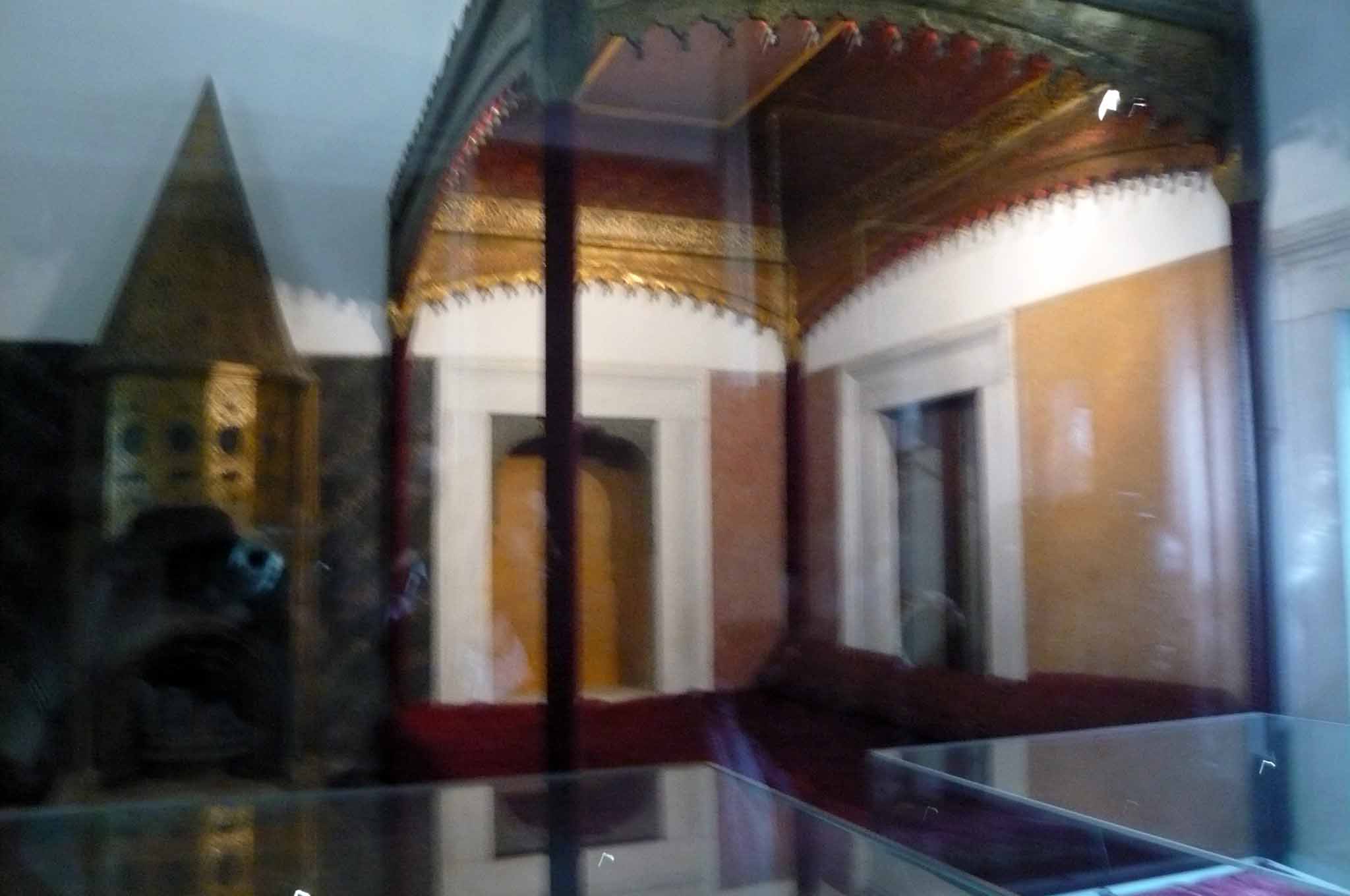

The Sultan's throne base

Part of the line of kitchens required to feed the entire palace community. Remember the palace was enormous, with several separate parts, numerous courtyards and open spaces - including a palace for the harem of as many as 1,000 - some leaving as late at 1909.
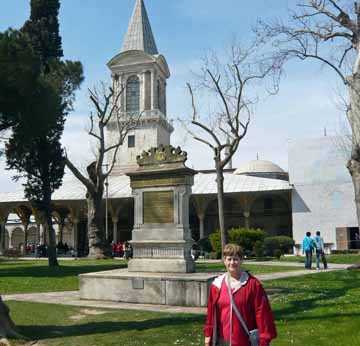 In the Second Courtyard
In the Second Courtyard
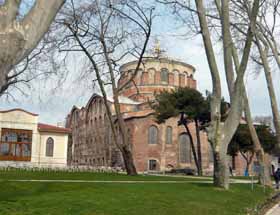
A view from outside the palace.
Grand Bazaar
Could not wait to see the Bazaar. While having heard about it for years, and being told it is a must see, we went in. I cannot pretend to provide a description that adequately pictures the size and complexity of the place. We were warned not to wander too far in , nor too far from the main isle or we could become lost - an understatement!
I have pictures, but they do the place not justice. As we walked down the main isle (street?) there were banner hanging overhead. As they told the picture of the Grand Bazaar better than I ever could describe it, I decided to just take pictures of the banner - conveniently in English. However, my lack of competency with a camera took this time to clearly demonstrate it. Consequently, most of the banner are not included and those that are probably shouldn't be. Try to read them and forgive me for the poor quality.
The Grand Bazaar ( Kapalıçarşı, meaning Covered Bazaar) in Istanbul is one of the largest and oldest covered markets in the world, with more than 58 covered streets and over 1,200 shops which attract between 250,000 and 400,000 visitors daily. Opened in 1461, it is well known for its jewelry, pottery, spice, and carpet shops. Many of the stalls in the bazaar are grouped by the type of goods, with special areas for leather coats, gold jewelry and the like. The bazaar contains two bedestens (domed masonry structures built for storage and safe keeping), the first of which was constructed between 1455 and 1461 by the order of Sultan Mehmed the Conqueror. The bazaar was vastly enlarged in the 16th century, during the reign of Sultan Suleiman the Magnificent, and in 1894 underwent a major restoration following an earthquake.

The main isle - very lightly filled with the crowds which we would see later.
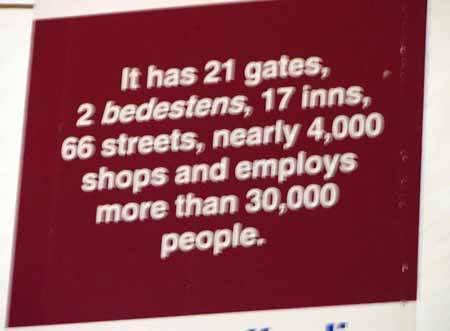
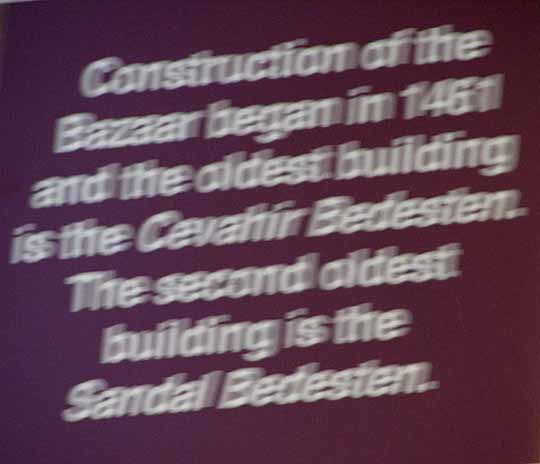
Some of the banners - please forgive me

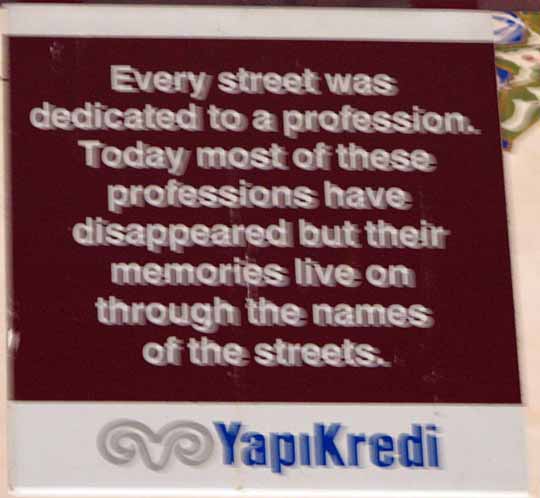
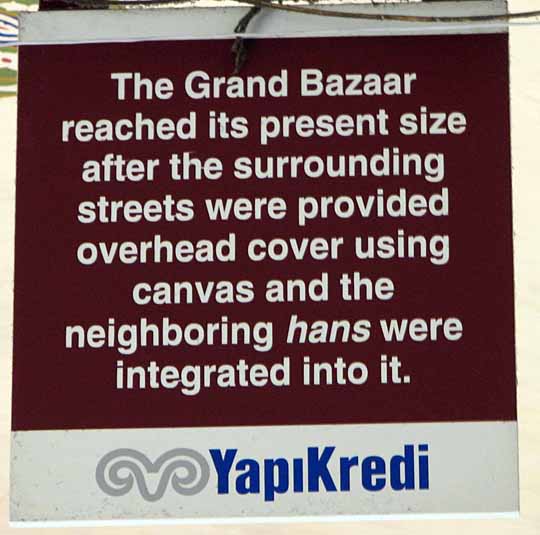
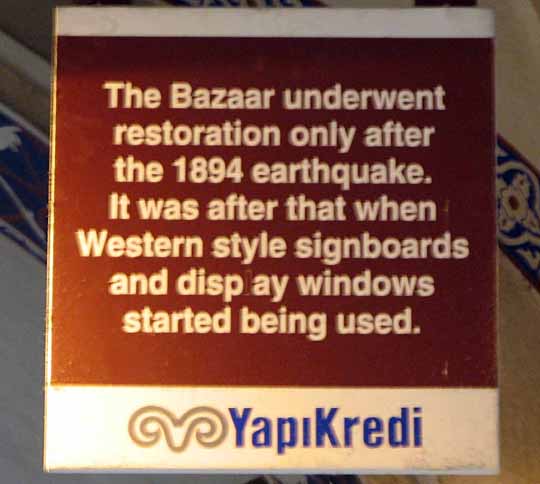
Spice Bazaar
OK - did not know until I read the guide books a few weeks prior to traveling to Turkey that there were TWO bazaars. The more I read, the more excited I became about the Spice Bazaar. If nothing else I wanted to buy some saffron - I was hoping I could afford it here at the source.
Also called the Egyptian Bazaar
is one of the oldest bazaars in the city. Located in Eminonu, it is the second
largest covered shopping complex after the Grand Bazaar.
There
are several documents suggesting the name of the bazaar was first "New
Bazaar". However, due to the fact that many spices were imported via Egypt
in the Ottoman period, the name "Mısır Çarşısı"
was favored by the public. The word mısır has a double meaning
in Turkish: "Egypt" and "maize". This is why sometimes the
name is wrongly translated as "Corn Bazaar". The bazaar was, and still
is, the center for spice trade in Istanbul.
The
building itself is part of the kullive of Yeni Mosque, and rents from the shops
within was intended to help pay for the upkeep of the mosque. The structure was
designed by the chief court architect Koca Kasam Aga, but completed by architect
Mustafa in 1660.
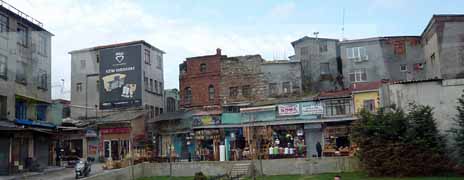
The Spice Bazaar has a courtyard and mosque (which owns the Spice Bazaar along side) on one side and in front, and a line of shops just off the street on the other side. Across the street is the river on which most of the tourist boats dock.
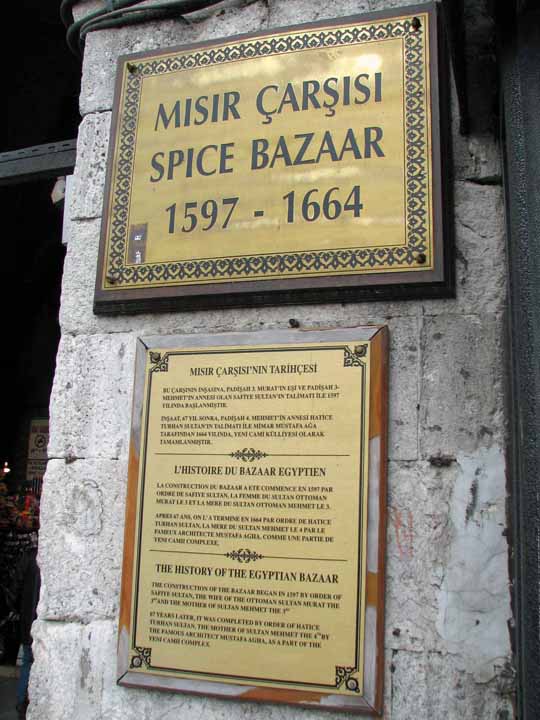
And what did you expect at a SPICE Bazaar?
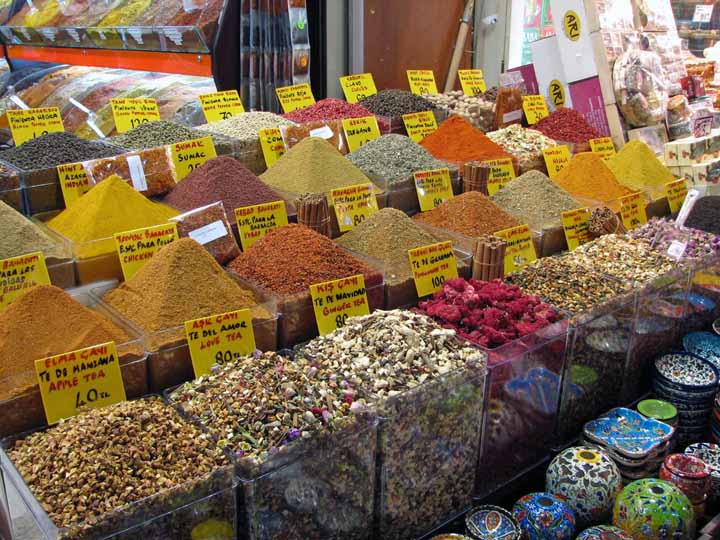
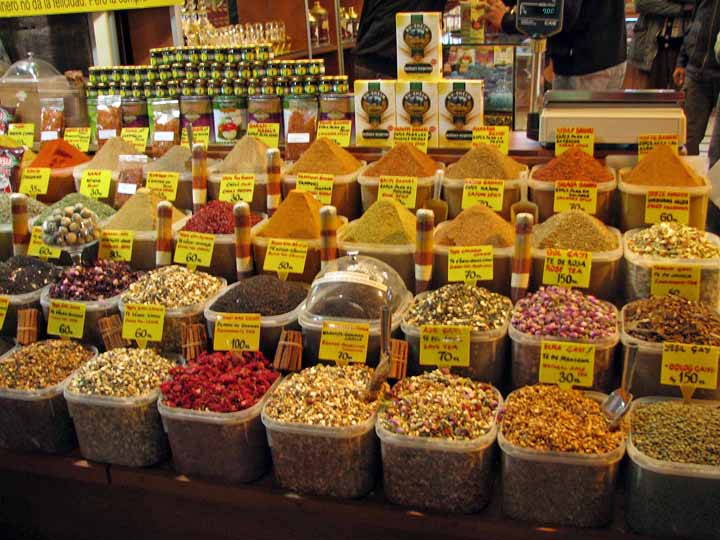
Oh, there's other things - like sausages and other dried meats, flowers, caviar, nuts, fruits, honey, candy (Turkish Delight), cheese and such. Look at the pictures that follow and see what all you see for sale.
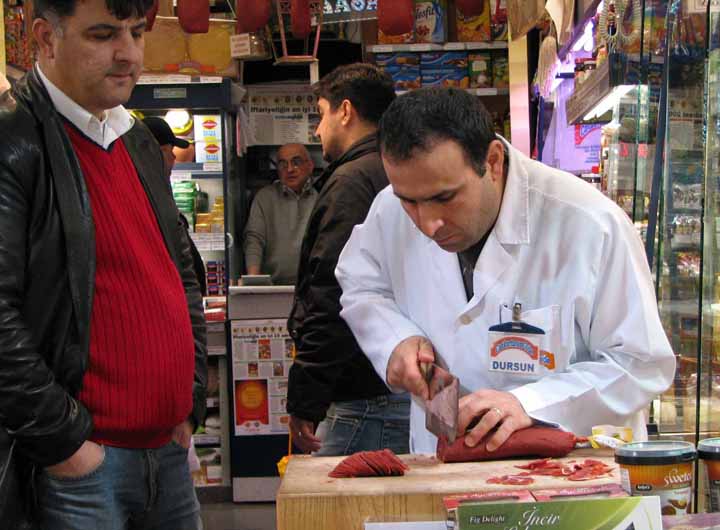
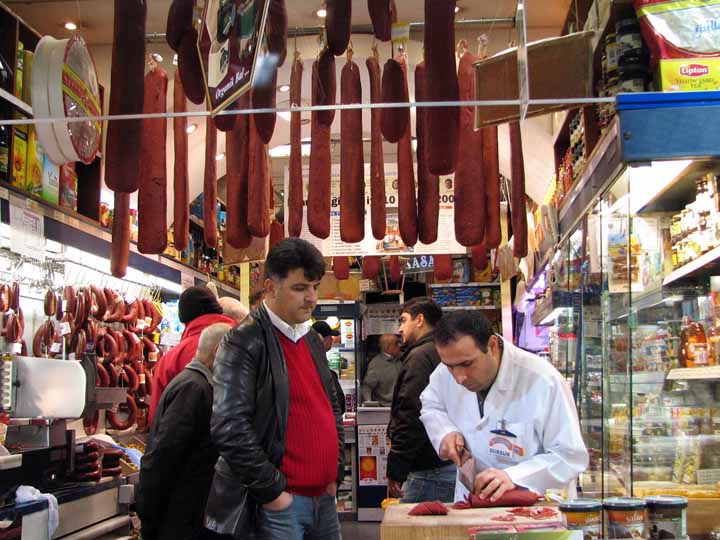

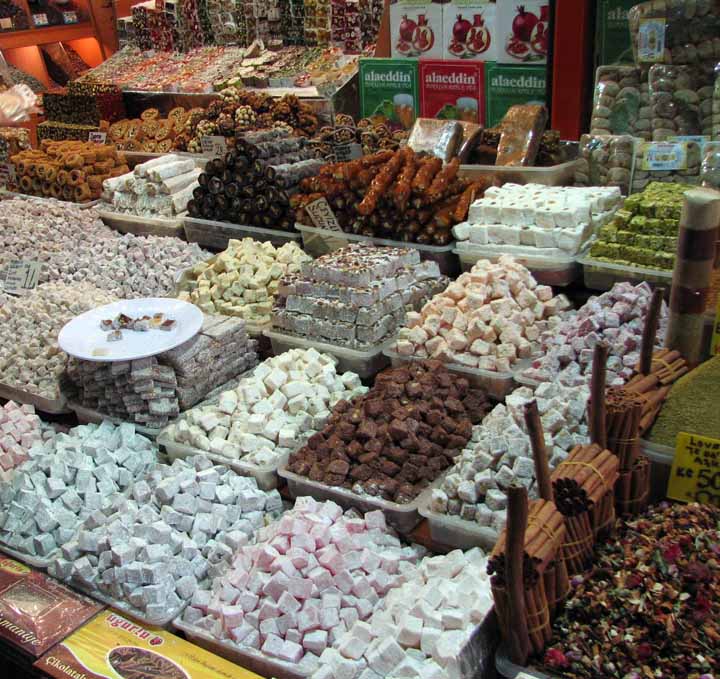
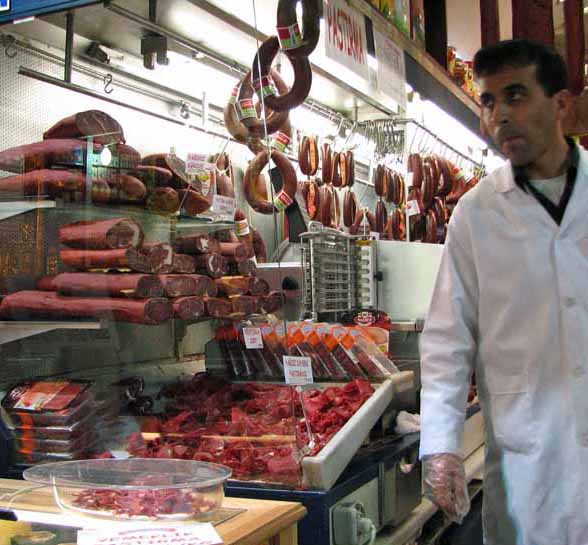

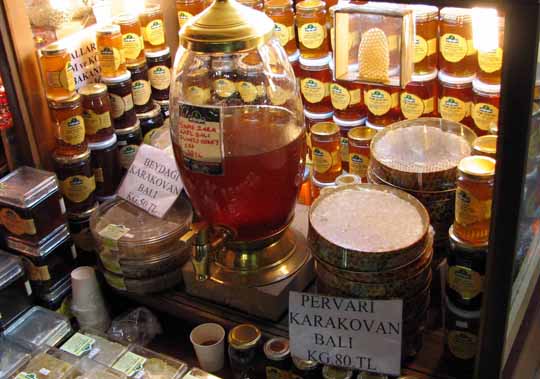
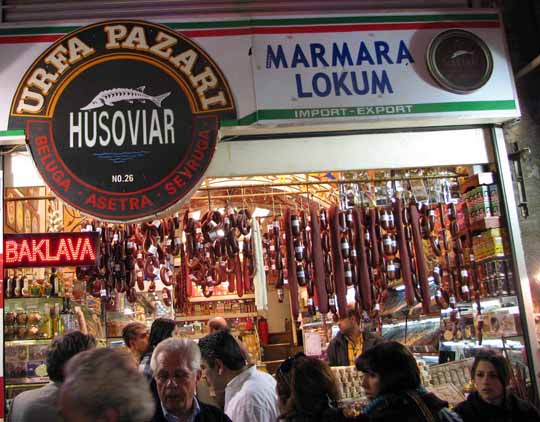
Ah, my friend Oman, below.
I bought some saffron form him, having "bargained" with him a few minutes. After buying it, he told me that what I bought was the common Turkish saffron, as is sold up and down the bazaar. However, in the back he had Iranian saffron - recognized as the best in the world. He tells me you can judge saffron by its color and how it colors water. The saffron he showed me was pure blood red, whereas the Turkish saffron was lighter and has a bit of other color to it. I had noticed this at other stalls. He took three threads of the Iranian saffron and placed it in a gallon jar of water. Quickly the red color spread down, and soon the entire gallon was discolored. Needless to say, he gave me a "discount" and I bought a couple packs.
A note: I saw him sell the same packs of Iranian saffron to Turkish customers without the discount. Hmmm?
A Second Note: On out last day in Turkey, I returned to Oman's shop to get a couple more packs of Iranian saffron. He remembered me! He came up, shook my hand asked how I enjoyed the country. I "bargained" for some more saffron, and as I ran out of Turkish currency, and was left with dollars, he cut the bargained price by 2/3 and threw in an other pack. I thanked him and he said - "You are not a customer - you are my friend." Quite the salesman. If I ever get back I'll look him up again....
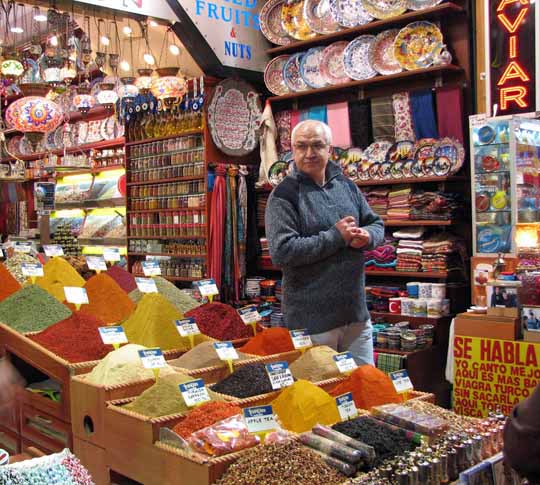
Oman - Warming up for my appearance. Second row, the first bin to the left -
Turkish saffron. Quite similar to all the other Turkish saffron I saw.
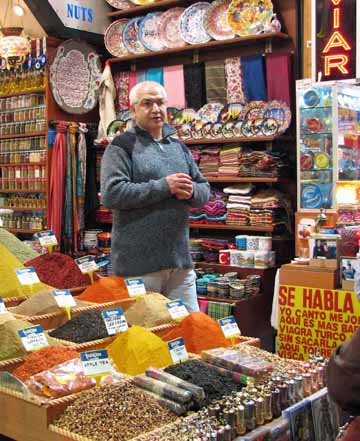

The rear of the shop
Looking down the main isle. 

Outside the bazaars were a court yard with street vendors selling several items - very much in demand by the Turkish pedestrians.
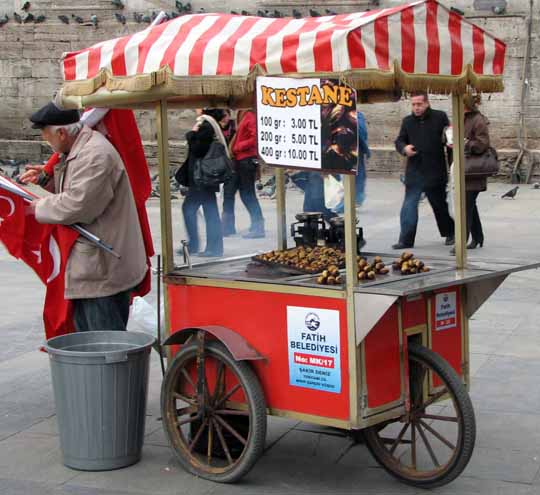

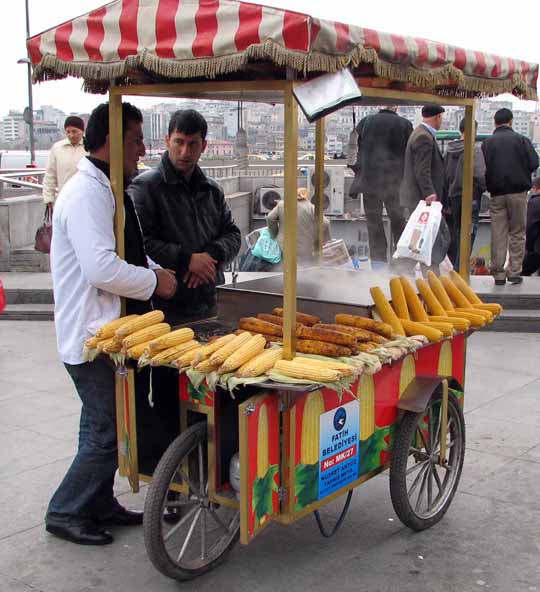
Along the exterior wall there were other fairly permanent shops. This one had about every imaginable type of nut. I bought a bag of corn nuts - which many of us enjoyed while on the bus for most of the trip.

Across the street, the river leading to the Bosphorus and the tourist boats. The buses, taxis and foot traffic is tremendous.
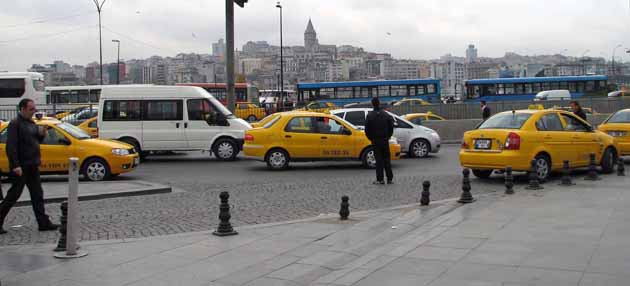
And yes, over the walls beyond the shops lining the street and court yard - one can see the Blue mosque.
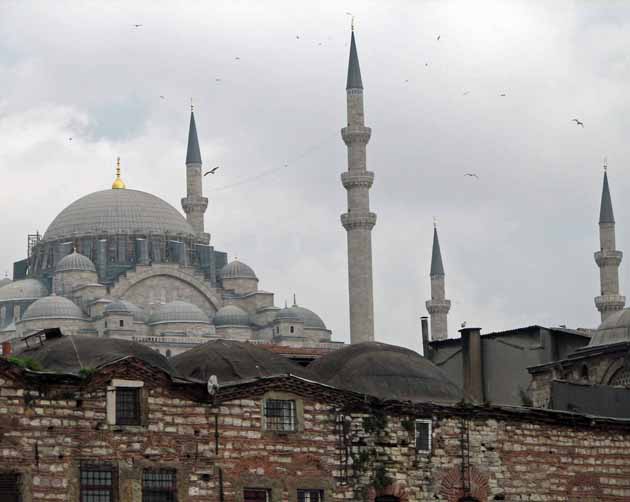
NOW - on to TROY !